Development of an IoT-Based SCADA System for Monitoring of Plant Leaf Temperature and Air and Soil Parameters
Abstract
:1. Introduction
- Our proposed system uses a low-cost IoT-based SCADA system produced by Xiamen Haiwell Technology [48]. We use the Haiwell IoT Cloud HMI, a small-sized SCADA server equipped with an HMI display that is remotely accessible via the Haiwell cloud.
- The monitored parameters combine the leaf temperature, air, and soil parameters. Since our proposed system provides more parameters than the existing works in Table 1, the plant condition can be analyzed in more detail.
- We propose a novel method to measure leaf temperature using a low-cost thermal camera, AMG8833 [49]. Our proposed system employs the 8 × 8 thermal camera and adopts a simple image thresholding technique to separate the leaf from the background for calculating the leaf temperature.
- We propose a novel method to visualize the thermal image from the thermal camera in the SCADA HMI, where the data are sent from the sensor using the Modbus TCP protocol via wireless communication and then displayed in the HMI using a graphic tool provided by a free Haiwell Cloud SCADA software.
- We comprehensively analyze the sensor data concerning vegetation behavior and instrument error reading.
2. Proposed System
2.1. IoT-Based SCADA System Configuration
- A low cost of about US$ 200.
- Support of the Modbus TCP protocol for easy interfacing with the sensor systems.
- Easy design and programming of the HMI using the free Haiwell Cloud SCADA software.
- Accessible from the cloud and mobile.
2.2. Sensors and Embedded System Hardware
2.2.1. Air Temperature and Humidity Sensor
2.2.2. Soil Sensor
2.2.3. Thermal Camera
2.2.4. Raspberry Pi Zero W
2.2.5. RS485 Modbus to WiFi Converter
2.3. Leaf Temperature Monitoring
- Apply the Otsu thresholding technique to separate an image into two parts, foreground and background, using an optimal threshold Topt;
- The foreground pixels are defined as the pixels whose values are lower than Topt, and the background pixels are defined as the pixels whose values are higher than Topt;
- The leaf temperature is defined as the average values of the foreground pixels, and the background temperature is defined as the average values of the background pixels.
2.4. SCADA HMI
2.4.1. Haiwell IoT Cloud HMI
2.4.2. Modbus TCP Configuration
- Modbus request: the message sent by the client to initiate a transaction,
- Modbus indication: the request message received on the server side,
- Modbus response: the response message sent by the server,
- Modbus confirmation: the response message received on the client side.
3. Experimental Results and Discussion
3.1. Hardware Implementation of Plant Monitoring System
3.2. HMI Dashboard
- The left part shows air monitoring.
- The center part shows leaf temperature monitoring.
- The right part shows soil monitoring.
- Historical trend of soil pH. It displays the trends in soil pH of Plant-1 and Plant-2.
- Historical trend of soil moisture. It displays the trends in soil moisture of Plant-1 and Plant-2.
- Historical trend of soil temperature. It displays the trends in soil temperature of Plant-1 and Plant-2.
- Historical trend of soil electrical conductivity (EC). It displays the trends in soil EC of Plant-1 and Plant-2.
- Historical trend of soil nitrogen. It displays the trends in soil nitrogen of Plant-1 and Plant-2.
- Historical trend of soil phosphorous. It displays the trends in soil phosphorous of Plant-1 and Plant-2.
- Historical trend of soil potassium. It displays the trends in soil potassium of Plant-1 and Plant-2.
- Historical trend of air and leaf temperature. It displays the trends in air temperature, and leaf and background temperatures of Plant-1 and Plant-2.
- Historical data group of soil parameters of Plant-1. It displays the historical data of soil pH, moisture, temperature, EC, and NPK of Plant-1.
- Historical data group of soil parameters of Plant-2. It displays the historical data of soil pH, moisture, temperature, EC, and NPK of Plant-2.
- Historical data group of air parameters and leaf temperature of Plant-1. It displays the historical data of air temperature and humidity, an average temperature of the thermal image, threshold, leaf, and background temperatures of Plant-1.
- Historical data group of leaf temperature of Plant-2. It displays the historical data of an average temperature of the thermal image, threshold, leaf, and background temperatures of Plant-2.
3.3. Performance of Hardware System
3.4. Performance of Leaf Temperature Measurement
3.5. Sensor Data Analysis
3.5.1. Air Temperature and Humidity
3.5.2. Leaf Temperature
3.5.3. Soil Parameters
- Soil temperature readings can be independently interpreted.
- Soil moisture readings should be interpreted by considering the soil temperature changes and watering treatment.
- Soil EC, pH, N, P, and K readings should be interpreted by considering the soil moisture reading.
3.6. Comparison to Existing Systems
4. Conclusions
Author Contributions
Funding
Institutional Review Board Statement
Informed Consent Statement
Data Availability Statement
Acknowledgments
Conflicts of Interest
References
- Pathmudi, V.R.; Khatri, N.; Kumar, S.; Abdul-Qawy, A.S.H.; Vyas, A.K. A Systematic Review of IoT Technologies and Their Constituents for Smart and Sustainable Agriculture Applications. Sci. Afr. 2023, 19, e01577. [Google Scholar] [CrossRef]
- Kour, V.P.; Arora, S. Recent Developments of the Internet of Things in Agriculture: A Survey. IEEE Access 2020, 8, 129924–129957. [Google Scholar] [CrossRef]
- Xu, J.; Gu, B.; Tian, G. Review of Agricultural IoT Technology. Artif. Intell. Agric. 2022, 6, 10–22. [Google Scholar] [CrossRef]
- Farooq, M.S.; Riaz, S.; Helou, M.A.; Khan, F.S.; Abid, A.; Alvi, A. Internet of Things in Greenhouse Agriculture: A Survey on Enabling Technologies, Applications, and Protocols. IEEE Access 2022, 10, 53374–53397. [Google Scholar] [CrossRef]
- Aubrecht, D.M.; Helliker, B.R.; Goulden, M.L.; Roberts, D.A.; Still, C.J.; Richardson, A.D. Continuous, Long-Term, High-Frequency Thermal Imaging of Vegetation: Uncertainties and Recommended Best Practices. Agric. For. Meteorol. 2016, 228–229, 315–326. [Google Scholar] [CrossRef]
- Yu, L.; Wang, W.; Zhang, X.; Zheng, W.; Yu, L.; Wang, W.; Zhang, X.; Zheng, W. A Review on Leaf Temperature Sensor: Measurement Methods and Application. In Computer and Computing Technologies in Agriculture IX. CCTA; Li, D., Li, Z., Eds.; Springer: Cham, Switzerland, 2016. [Google Scholar] [CrossRef]
- Zhou, Z.; Diverres, G.; Kang, C.; Thapa, S.; Karkee, M.; Zhang, Q.; Keller, M. Ground-Based Thermal Imaging for Assessing Crop Water Status in Grapevines over a Growing Season. Agronomy 2022, 12, 322. [Google Scholar] [CrossRef]
- Kokin, E.; Pennar, M.; Palge, V.; Jürjenson, K. Strawberry Leaf Surface Temperature Dynamics Measured by Thermal Camera in Night Frost Conditions. Agron. Res. 2018, 16, 122–133. [Google Scholar] [CrossRef]
- Iseki, K.; Olaleye, O. A New Indicator of Leaf Stomatal Conductance Based on Thermal Imaging for Field Grown Cowpea. Plant Prod. Sci. 2020, 23, 136–147. [Google Scholar] [CrossRef]
- Giménez-Gallego, J.; González-Teruel, J.D.; Soto-Valles, F.; Jiménez-Buendía, M.; Navarro-Hellín, H.; Torres-Sánchez, R. Intelligent Thermal Image-Based Sensor for Affordable Measurement of Crop Canopy Temperature. Comput. Electron. Agric. 2021, 188, 106319. [Google Scholar] [CrossRef]
- Kim, B. Design and Implementation of Low-Cost Thermal-RGB Camera for Remote Monitoring Crop. Glob. J. Eng. Sci. 2021, 8, 8–10. [Google Scholar]
- Son, K.H.; Sim, H.S.; Lee, J.K.; Lee, J. Precise Sensing of Leaf Temperatures for Smart Farm Applications. Horticulturae 2023, 9, 518. [Google Scholar] [CrossRef]
- Noguera, M.; Millán, B.; Pérez-Paredes, J.J.; Ponce, J.M.; Aquino, A.; Andújar, J.M. A New Low-Cost Device Based on Thermal Infrared Sensors for Olive Tree Canopy Temperature Measurement and Water Status Monitoring. Remote Sens. 2020, 12, 723. [Google Scholar] [CrossRef]
- Absar, M.H.; Mirza, G.F.; Zakai, W.; John, Y.; Mansoor, N. Novel IoT-Based Plant Monitoring System. Eng. Proc. 2023, 23, 12. [Google Scholar]
- Wayangkau, I.H.; Mekiuw, Y.; Rachmat, R.; Suwarjono, S.; Hariyanto, H. Utilization of IoT for Soil Moisture and Temperature Monitoring System for Onion Growth. Emerg. Sci. J. 2020, 4, 102–115. [Google Scholar] [CrossRef]
- Marcu, I.; Suciu, G.; Bǎlǎceanu, C.; Drǎgulinescu, A.M.; Dobrea, M.A. IoT Solution for Plant Monitoring in Smart Agriculture. In Proceedings of the 2019 IEEE 25th International Symposium for Design and Technology in Electronic Packaging (SIITME), Cluj-Napoca, Romania, 23–26 October 2019; pp. 194–197. [Google Scholar] [CrossRef]
- Moshayedi, A.J.; Roy, A.S.; Liao, L.; Li, S. Raspberry Pi SCADA Zonal Based System for Agricultural Plant Monitoring. In Proceedings of the 2019 6th International Conference on Information Science and Control Engineering (ICISCE), Shanghai, China, 20–22 December 2019; pp. 427–433. [Google Scholar] [CrossRef]
- Ma, H.; Qi, J.; Li, K.; He, C. Plant Growth Monitoring Cloud Platform Based on Internet of Things. In Proceedings of the 2021 6th International Conference on Intelligent Computing and Signal Processing (ICSP), Xi’an, China, 9–11 April 2021; No. Icsp. pp. 1126–1129. [Google Scholar] [CrossRef]
- Abdullah, N.; Durani, N.A.B.; Bin Shari, M.F.; Siong, K.S.; Hau, V.K.W.; Siong, W.N.; Ahmad, I.K.A. Towards Smart Agriculture Monitoring Using Fuzzy Systems. IEEE Access 2021, 9, 4097–4111. [Google Scholar] [CrossRef]
- Carlos, A.D.J.; Augusto, C.-R.C.; Patricia, A.-C.P.; Alberto, P.-M.M.; Enrique, R.G.R.; César, M.-O.R.; Alfredo, O.-G.D.; Andrés, C.-M.C. Monitoring System of Environmental Variables for a Strawberry Crop Using IoT Tools. Procedia Comput. Sci. 2020, 170, 1083–1089. [Google Scholar] [CrossRef]
- Jamal, J.; Azizi, S.; Abdollahpouri, A.; Ghaderi, N.; Sarabi, B.; Silva-Ordaz, A.; Castaño-Meneses, V.M. Monitoring Rocket (Eruca Sativa) Growth Parameters Using the Internet of Things under Supplemental LEDs Lighting. Sens. Bio-Sens. Res. 2021, 34, 100450. [Google Scholar] [CrossRef]
- Zhang, S.; Guo, Y.; Li, S.; Ke, Z.; Zhao, H.; Yang, J.; Wang, Y.; Li, D.; Wang, L.; Yang, W.; et al. Investigation on Environment Monitoring System for a Combination of Hydroponics and Aquaculture in Greenhouse. Inf. Process. Agric. 2022, 9, 123–134. [Google Scholar] [CrossRef]
- Maginga, T.J.; Bakunzibake, P.; Masabo, E.; Massawe, D.P.; Agbedanu, P.R.; Nsenga, J. Design and Implementation of IoT Sensors for Nonvisual Symptoms Detection on Maize Inoculated with Exserohilum Turcicum. Smart Agric. Technol. 2023, 5, 100260. [Google Scholar]
- Madhumathi, R.; Arumuganathan, T.; Shruthi, R. Soil NPK and Moisture Analysis Using Wireless Sensor Networks. In Proceedings of the 2020 11th International Conference on Computing, Communication and Networking Technologies (ICCCNT), Kharagpur, India, 1–3 July 2020. [Google Scholar] [CrossRef]
- Nuchhi, S.; Bagali, V.; Annigeri, S. IOT Based Soil Testing Instrument for Agriculture Purpose. In Proceedings of the 2020 IEEE Bangalore Humanitarian Technology Conference (B-HTC), Vijiyapur, India, 8–10 October 2020; pp. 17–20. [Google Scholar] [CrossRef]
- Postolache, S.; Sebastião, P.; Viegas, V.; Postolache, O.; Cercas, F. IoT-Based Systems for Soil Nutrients Assessment in Horticulture. Sensors 2022, 23, 403. [Google Scholar] [CrossRef]
- Lavanya, G.; Rani, C.; GaneshKumar, P. An Automated Low Cost IoT Based Fertilizer Intimation System for Smart Agriculture. Sustain. Comput. Inform. Syst. 2020, 28, 100300. [Google Scholar] [CrossRef]
- Pyingkodi, M.; Thenmozhi, K.; Karthikeyan, M.; Kalpana, T.; Palarimath, S.; Kumar, G.B.A. IoT Based Soil Nutrients Analysis and Monitoring System for Smart Agriculture. In Proceedings of the 2022 3rd International Conference on Electronics and Sustainable Communication Systems (ICESC), Coimbatore, India, 17–19 August 2022; pp. 489–494. [Google Scholar] [CrossRef]
- Soetedjo, A.; Lomi, A.; Nakhoda, Y.I. Incorporating SCADA Software and High Level Language for Implementing the Optimization Technique in Smart Grid. Int. J. Innov. Comput. Inf. Control 2017, 13, 711–726. [Google Scholar]
- Alanazi, M.; Mahmood, A.; Chowdhury, M.J.M. SCADA Vulnerabilities and Attacks: A Review of the State-of-the-art and Open Issues. Comput. Secur. 2023, 125, 103028. [Google Scholar] [CrossRef]
- Hashem, M.Y.M.; Osman, F.A.; Eltokhy, M.A.R.; Allah, A.S.G. Low-Cost Design and Implementation of Cloud SCADA System. J. Eng. Res. 2020, 166, ELE15–ELE29. [Google Scholar] [CrossRef]
- Yi, M.; Mueller, H.; Yu, L.; Chuan, J. Benchmarking Cloud-Based SCADA System. In Proceedings of the 2017 IEEE International Conference on Cloud Computing Technology and Science (CloudCom), Hong Kong, China, 11–14 December 2017; pp. 122–129. [Google Scholar] [CrossRef]
- Tom, R.J.; Sankaranarayanan, S. IoT Based SCADA Integrated with Fog for Power Distribution Automation. In Proceedings of the 2017 12th Iberian Conference on Information Systems and Technologies (CISTI), Lisbon, Portugal, 21–24 June 2017; pp. 1–4. [Google Scholar] [CrossRef]
- Vargas-Salgado, C.; Aguila-Leon, J.; Chiñas-Palacios, C.; Hurtado-Perez, E. Low-Cost Web-Based Supervisory Control and Data Acquisition System for a Microgrid Testbed: A Case Study in Design and Implementation for Academic and Research Applications. Heliyon 2019, 5, e02474. [Google Scholar] [CrossRef] [PubMed]
- Aghenta, L.O.; Iqbal, M.T. Development of an IoT Based Open Source SCADA System for PV System Monitoring. In Proceedings of the 2019 IEEE Canadian Conference of Electrical and Computer Engineering (CCECE), Edmonton, AB, Canada, 5–8 May 2019; pp. 1–4. [Google Scholar] [CrossRef]
- Aghenta, L.O.; Iqbal, M.T. A Low-Cost, Open Source IoT-Based SCADA System Design, and Implementation for Photovoltaics. In Proceedings of the 28th Annual Newfoundland Electrical and Computer Engineering Conference, Newfoundland and Labrador, St. John’s, NL, Canada, 19 November 2019; pp. 1–5. [Google Scholar]
- Myint, A.K.; Latt, K.Z.; Hla, T.T.; Tun, N.M. IoT-Based SCADA System Design and Generation Forecasting for Hydropower Station. Int. J. Electr. Electron. Eng. Telecommun. 2021, 10, 251–260. [Google Scholar] [CrossRef]
- Aghenta, L.O.; Iqbal, M.T. Low-Cost, Open Source IoT-Based SCADA System Design Using Thinger.IO and ESP32 Thing. Electronics 2019, 8, 822. [Google Scholar] [CrossRef]
- Fazlollahtabar, H. Internet of Things-Based SCADA System for Configuring/Reconfiguring an Autonomous Assembly Process. Robotica 2022, 40, 672–689. [Google Scholar] [CrossRef]
- Salem, R.M.M.; Saraya, M.S.; Ali-Eldin, A.M.T. An Industrial Cloud-Based IoT System for Real-Time Monitoring and Controlling of Wastewater. IEEE Access 2022, 10, 6528–6540. [Google Scholar] [CrossRef]
- Oton, C.N.; Iqbal, M.T. Low-Cost Open Source IoT-Based SCADA System for a BTS Site Using ESP32 and Arduino IoT Cloud. In Proceedings of the 2021 IEEE 12th Annual Ubiquitous Computing, Electronics and Mobile Communication Conference, UEMCON, New York, NY, USA, 1–4 December 2021; pp. 681–685. [Google Scholar] [CrossRef]
- Pachamanov, A.; Georgiev, K. Tunnel Lighting Control System as a Component of SCADA Cloud Technology for Road Section. In Proceedings of the 2020 Fifth Junior Conference on Lighting (Lighting), Ruse, Bulgaria, 24–26 September 2020. [Google Scholar] [CrossRef]
- Osman, F.A. Secured Cloud SCADA System Implementation for Industrial Applications. Multimedia Tools Appl. 2022, 81, 9989–10005. [Google Scholar]
- Osaretin, C.A.; Zamanlou, M.; Iqbal, M.T.; Butt, S. Open Source IoT-Based SCADA System for Remote Oil Facilities Using Node-RED and Arduino Microcontrollers. In Proceedings of the 2020 11th IEEE Annual Information Technology, Electronics and Mobile Communication Conference (IEMCON), Vancouver, BC, Canada, 4–7 November 2020; pp. 571–575. [Google Scholar] [CrossRef]
- Grigorescu, S.D.; Seritan, G.C.; Enache, B.A.; Argatu, F.C.; Adochiei, F.C. Open Source Architecture for Iot Based SCADA System for Smart Home. Sci. Bull. Electr. Eng. Fac. 2020, 20, 33–36. [Google Scholar] [CrossRef]
- Church, P.; Mueller, H.; Ryan, C.; Gogouvitis, S.V.; Goscinski, A.; Haitof, H.; Tari, Z. Moving SCADA Systems to IaaS Clouds. In Proceedings of the 2015 IEEE International Conference on Smart City/SocialCom/SustainCom (SmartCity), Chengdu, China, 19–21 December 2015; pp. 908–914. [Google Scholar] [CrossRef]
- Zamanlou, M.; Iqbal, M.T. Development of an Economical SCADA System for Solar Water Pumping in Iran. In Proceedings of the 2020 IEEE International IOT, Electronics and Mechatronics Conference (IEMTRONICS), Vancouver, BC, Canada, 9–12 September 2020; pp. 31–34. [Google Scholar] [CrossRef]
- Haiwell. Available online: http://en.haiwell.com/ (accessed on 3 May 2022).
- Grid-EYE® Infrared Array Sensor. Available online: https://na.industrial.panasonic.com/products/sensors/sensors-automotive-industrial-applications/lineup/grid-eye-infrared-array-sensor (accessed on 3 February 2023).
- Raspberry Pi Zero W. Available online: https://www.raspberrypi.com/products/raspberry-pi-zero-w/ (accessed on 10 December 2022).
- 7 in 1 Integrated Soil Sensor EC PH NPK Moisture Temperature Meter. Available online: https://www.jxct-iot.com/product/showproduct.php?id=197 (accessed on 8 April 2023).
- Elfin-EW11. Available online: http://www.hi-flying.com/elfin-ew10-elfin-ew11 (accessed on 10 June 2022).
- DHT22-Digital-Output Relative Humidity & Temperature Sensor. Available online: https://datasheetspdf.com/pdf-file/792211/Aosong/DHT22/1 (accessed on 3 February 2023).
- Bellosta-Diest, A.; Campo-Bescós, M.; Zapatería-Miranda, J.; Casalí, J.; Arregui, L.M. Evaluation of Nitrate Soil Probes for a More Sustainable Agriculture. Sensors 2022, 22, 9288. [Google Scholar] [CrossRef] [PubMed]
- Sezgin, M.; Sankur, B. Survey over Image Thresholding Techniques and Quantitative Performance Evaluation. J. Electron. Imaging 2004, 13, 220. [Google Scholar] [CrossRef]
- Modbus-IDA. Modbus Messaging on Tcp/Ip Implementation Guide; Modbus Organization: Andover, MA, USA, 2006. [Google Scholar]
- Modbus-IDA. Modbus Application Protocol Specification V1.1a; Modbus Organization: Andover, MA, USA, 2004. [Google Scholar]
- Konrad, W.; Katul, G.; Roth-Nebelsick, A. Leaf Temperature and Its Dependence on Atmospheric CO2 and Leaf Size. Geol. J. 2021, 56, 866–885. [Google Scholar] [CrossRef]
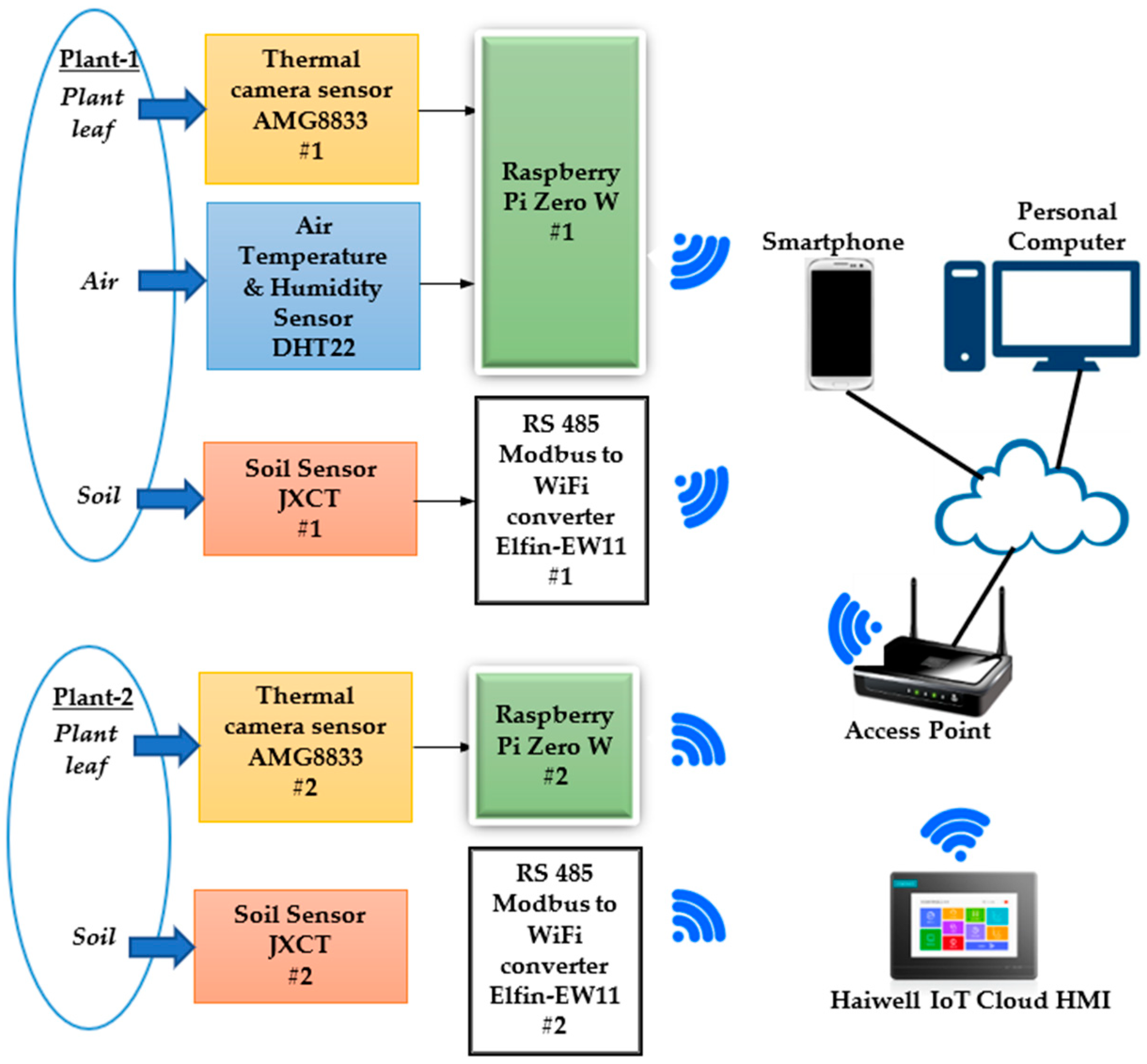
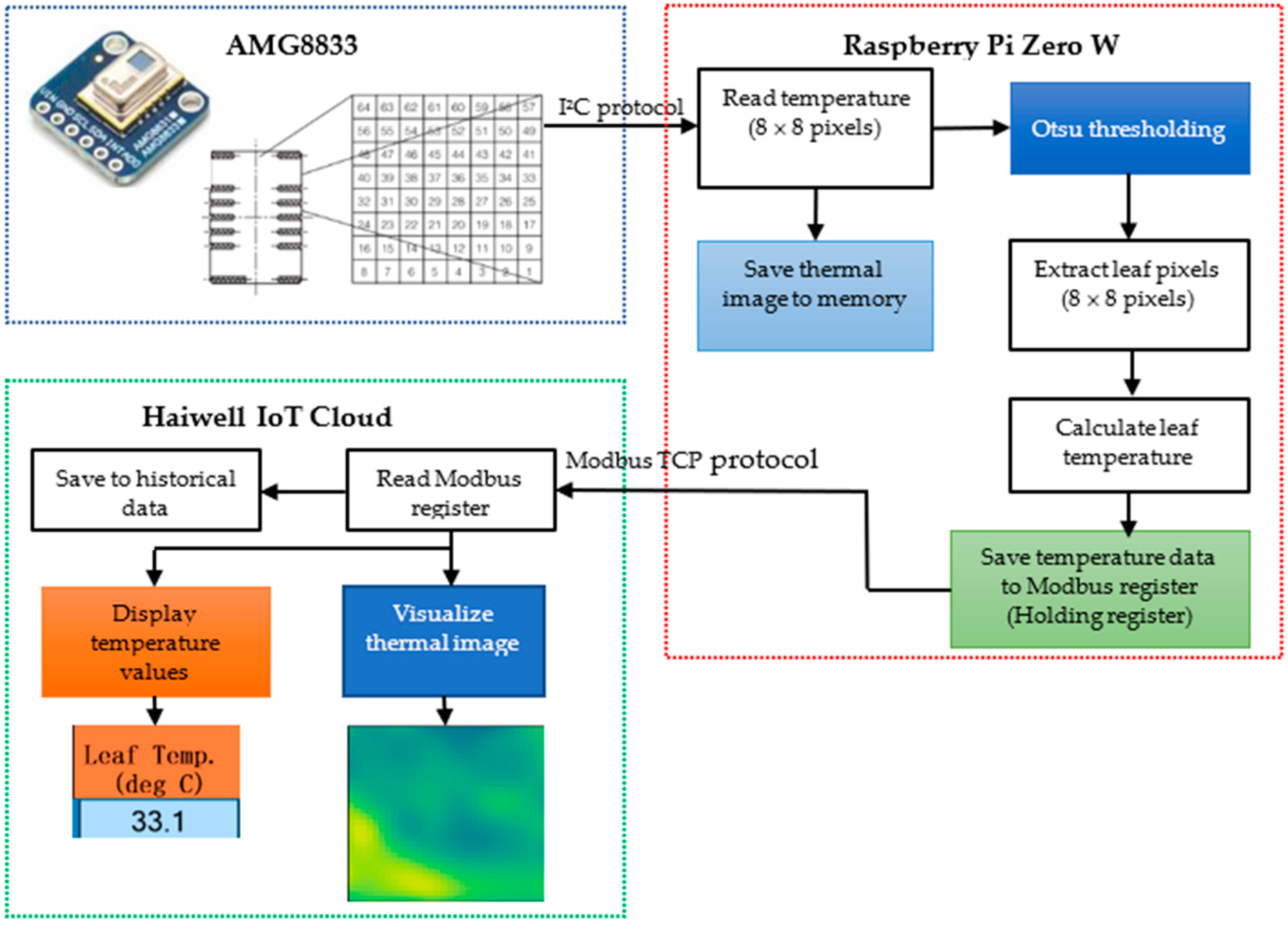
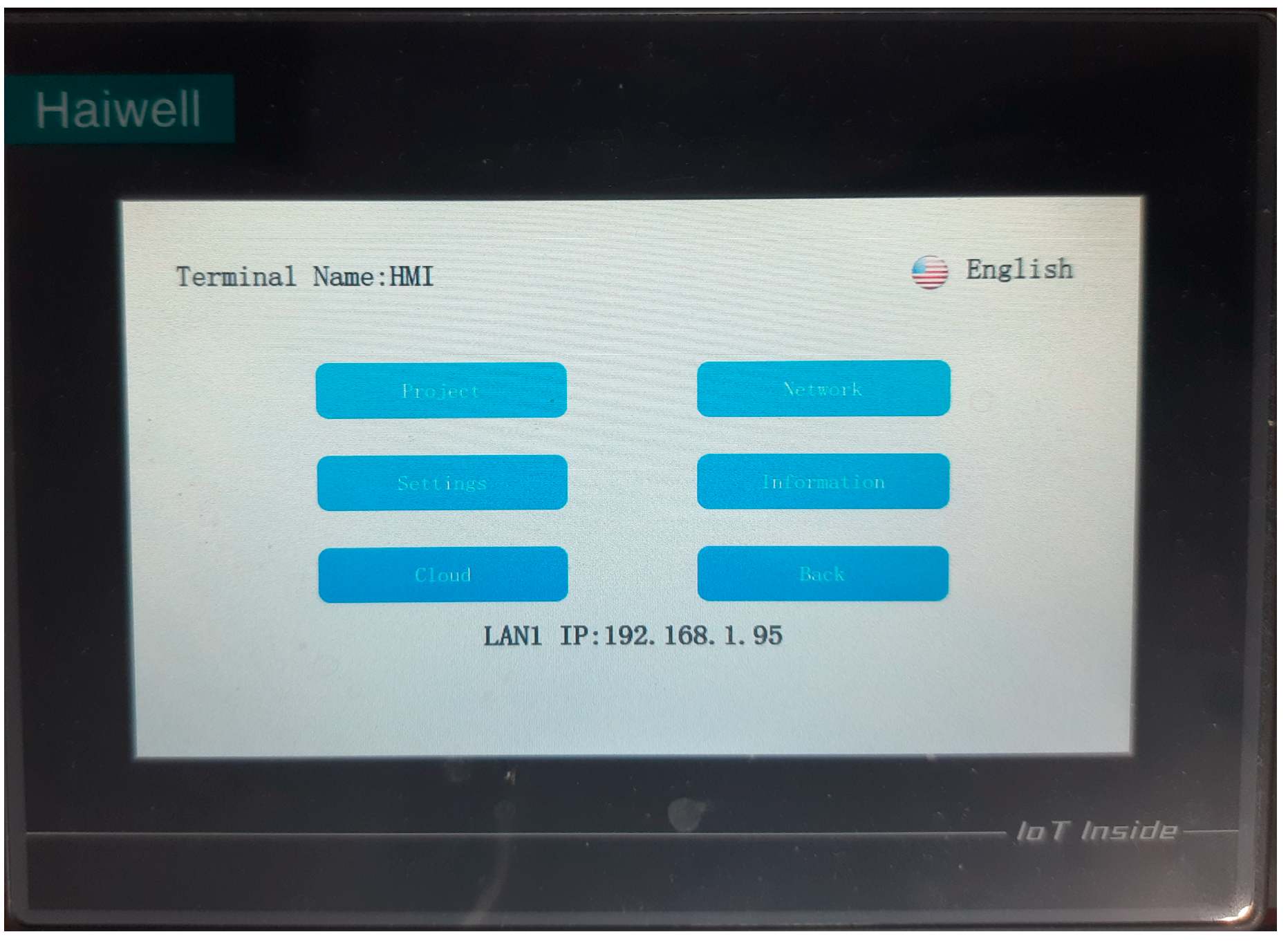



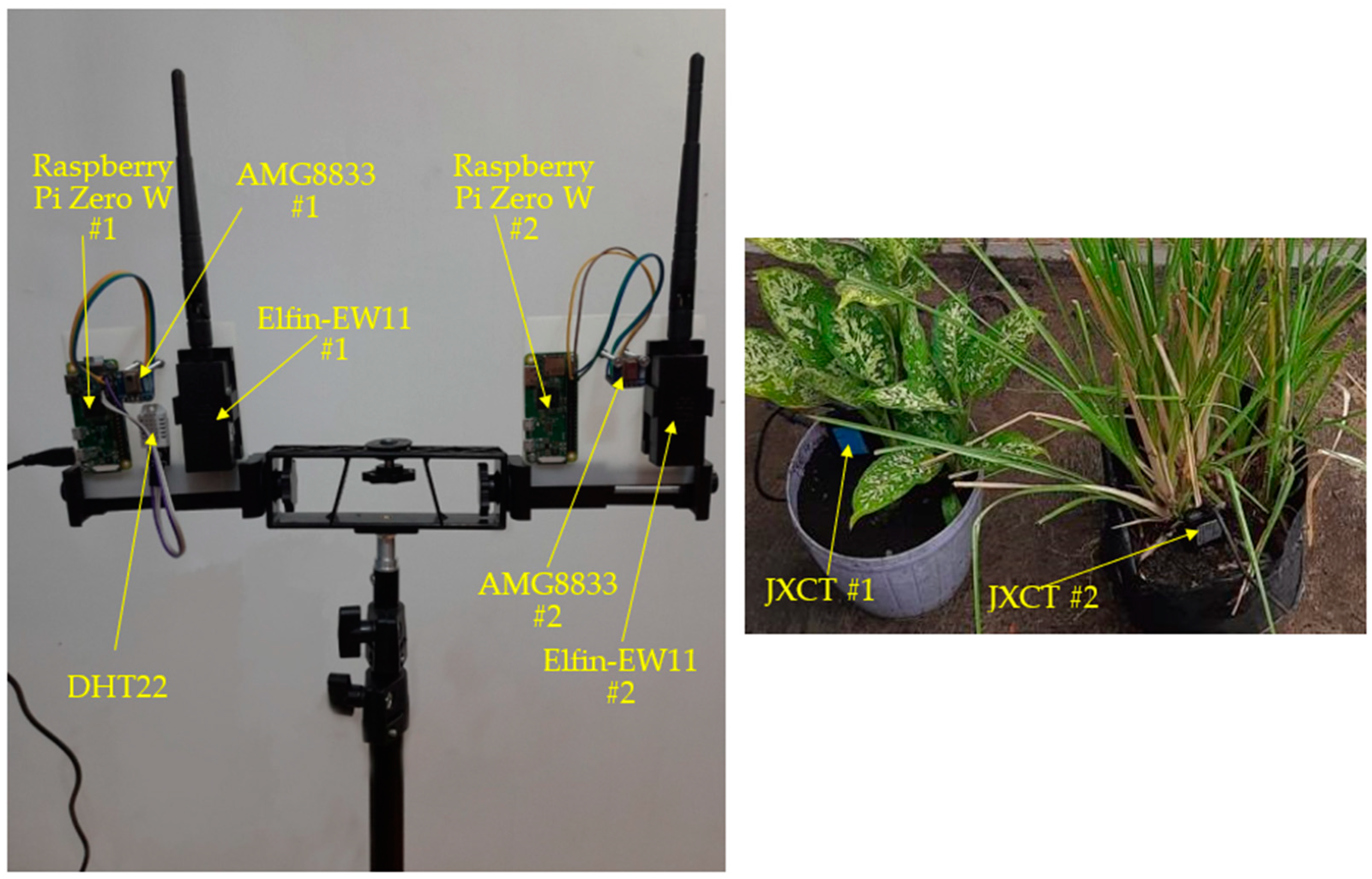
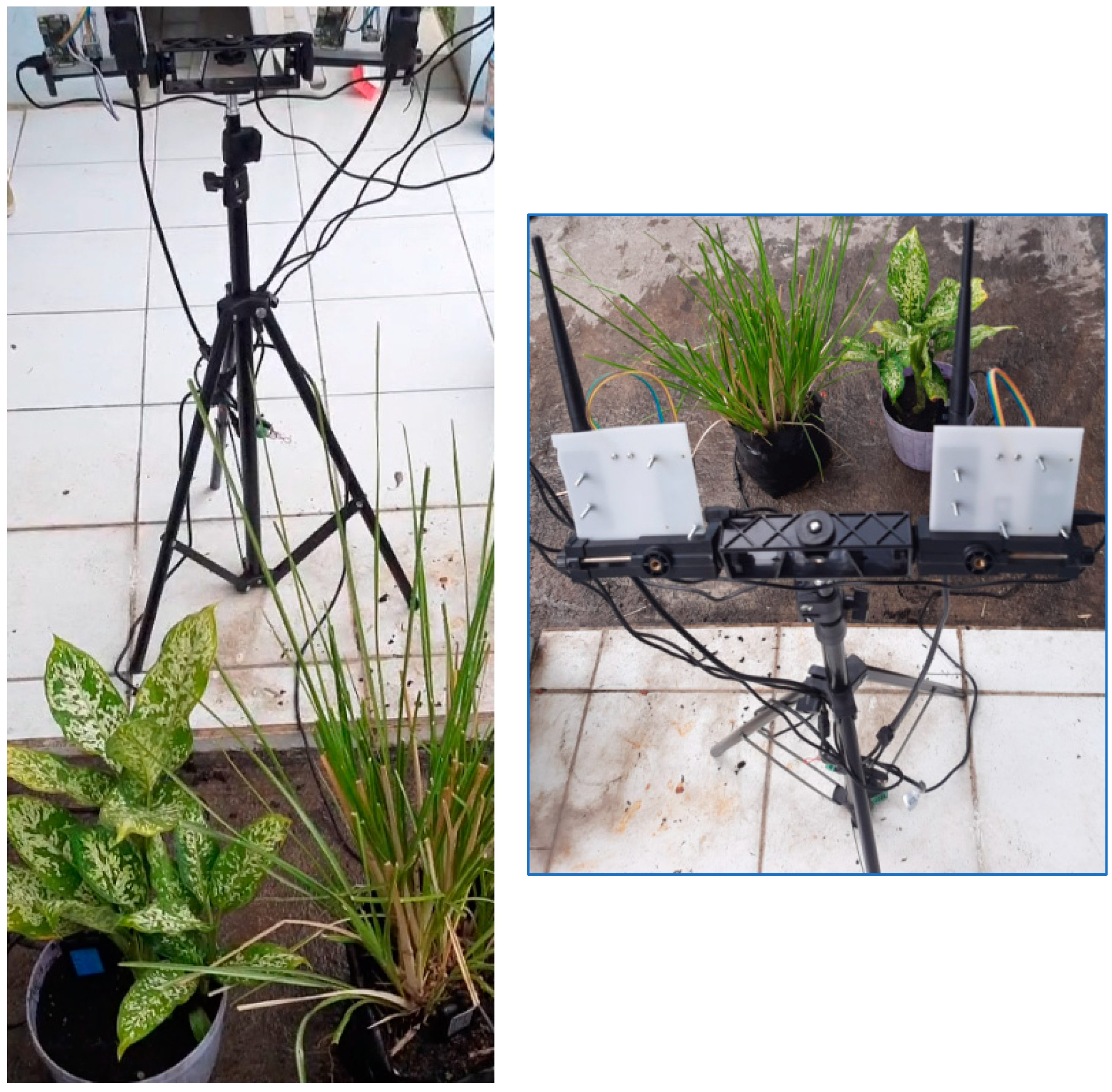
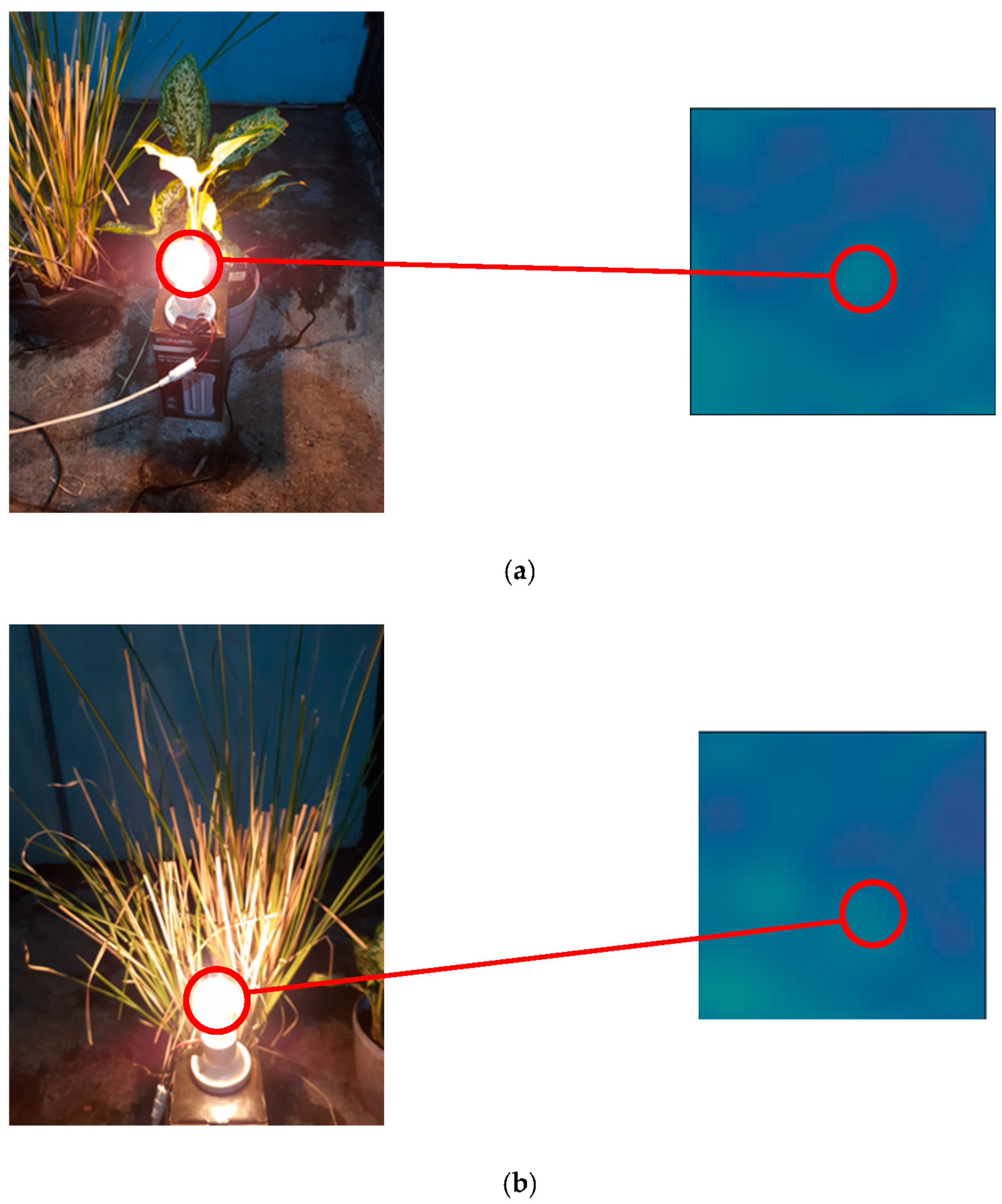
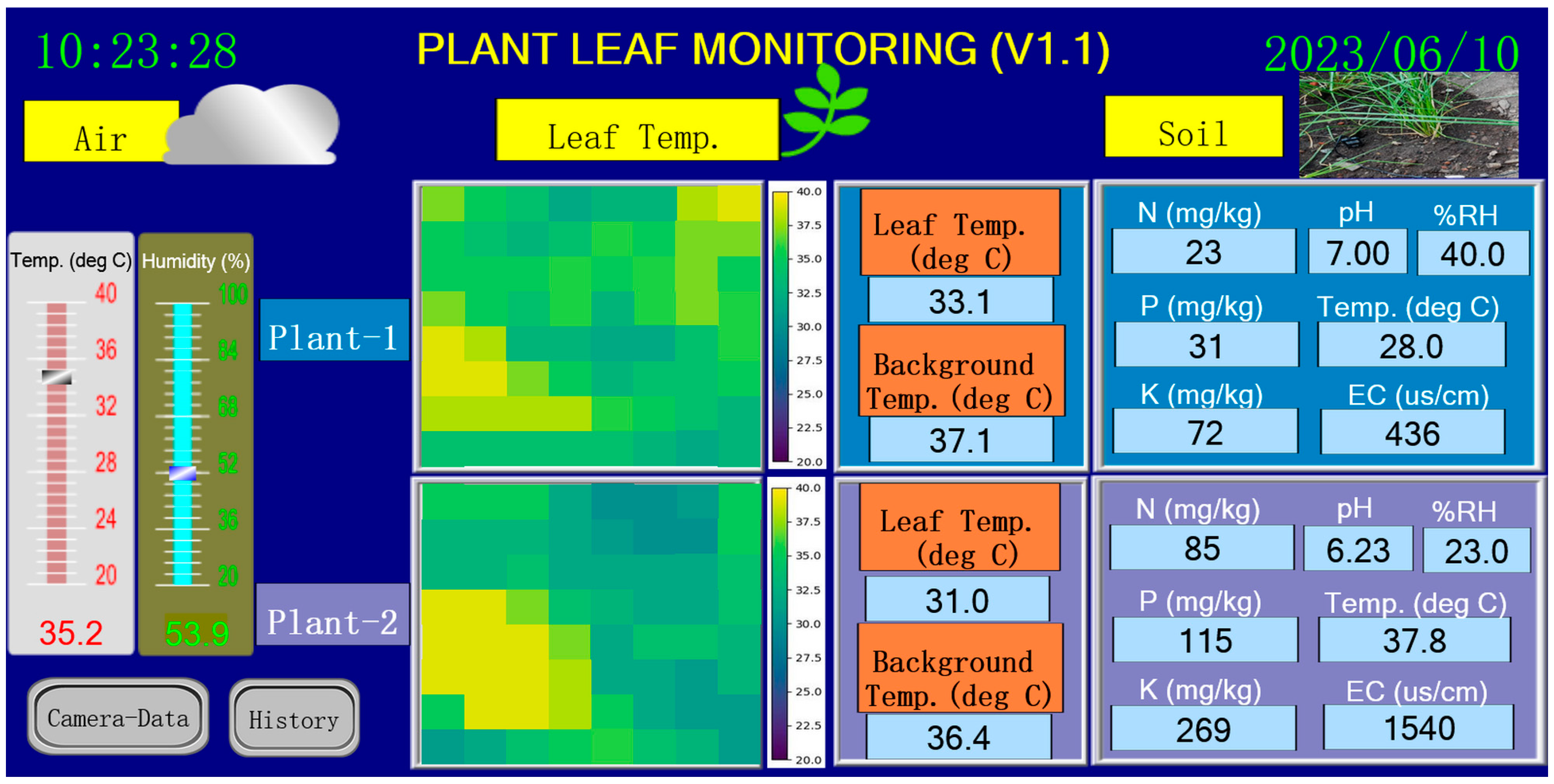
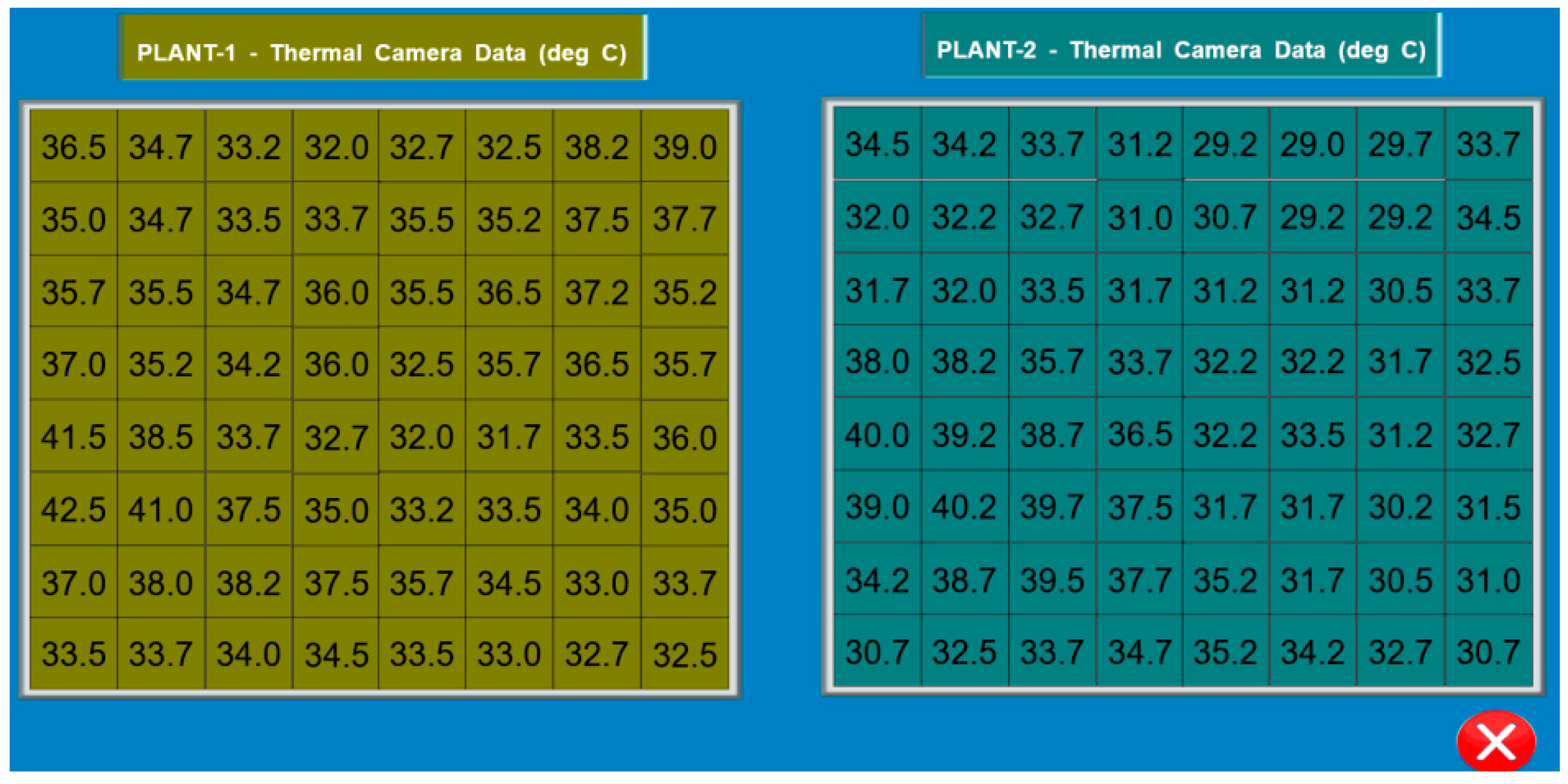

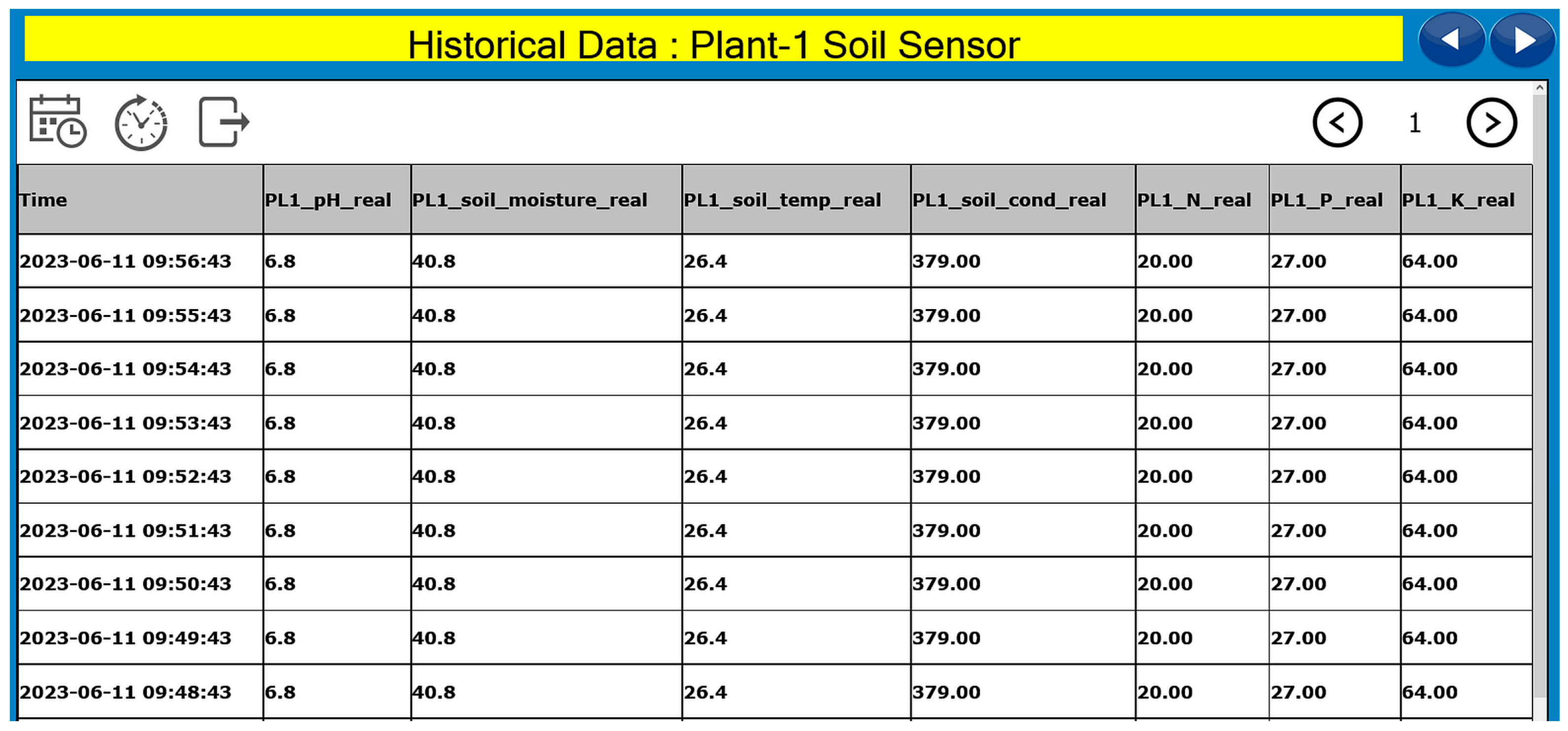
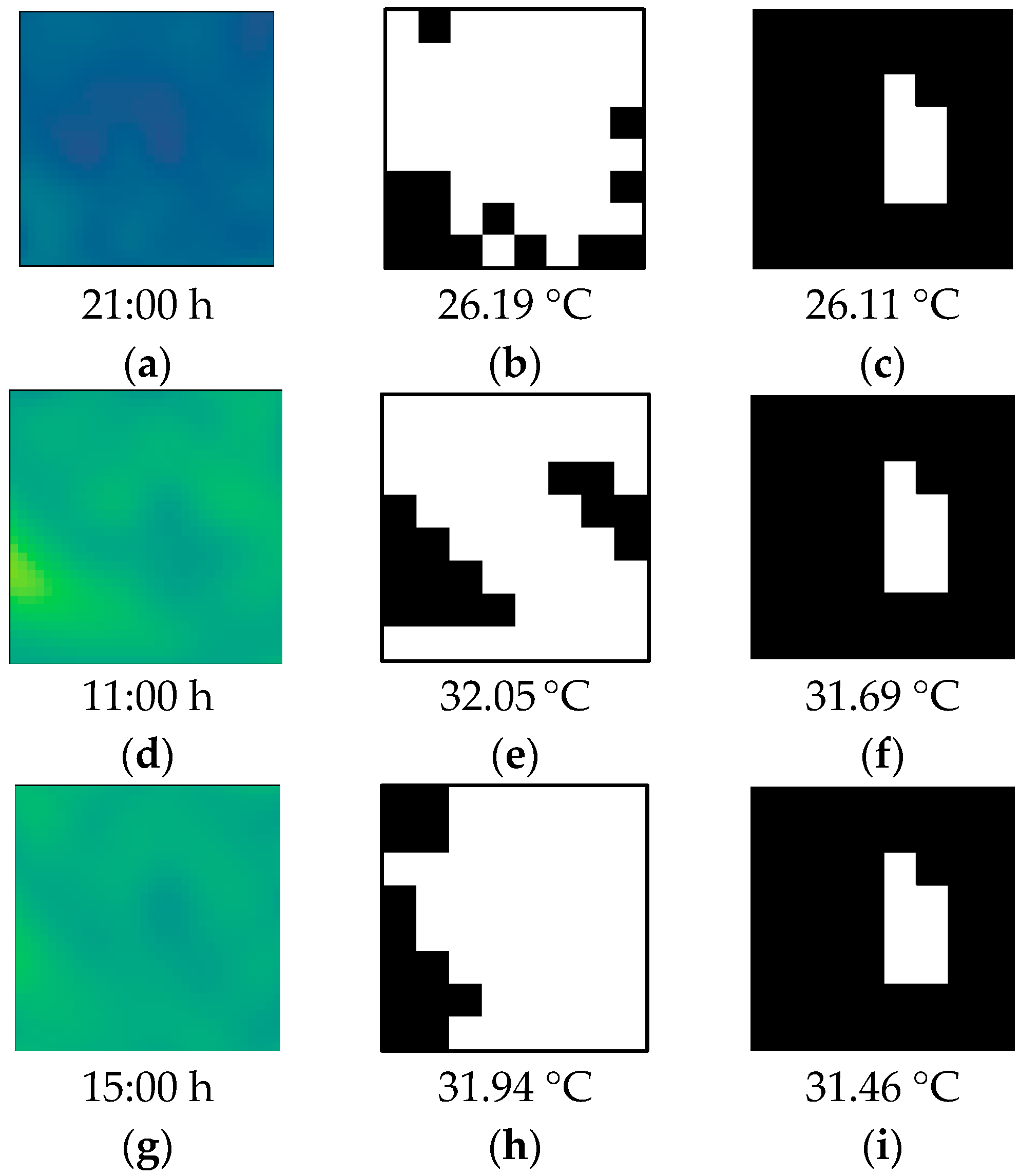
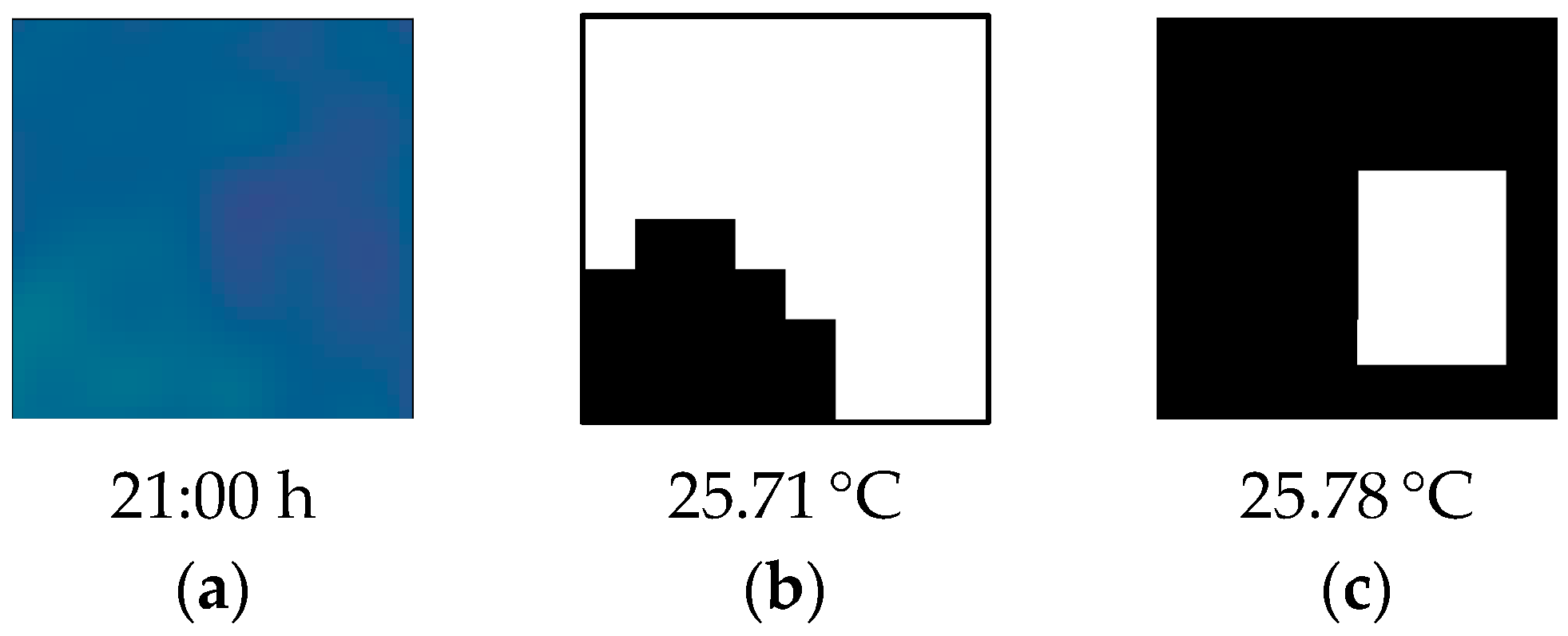
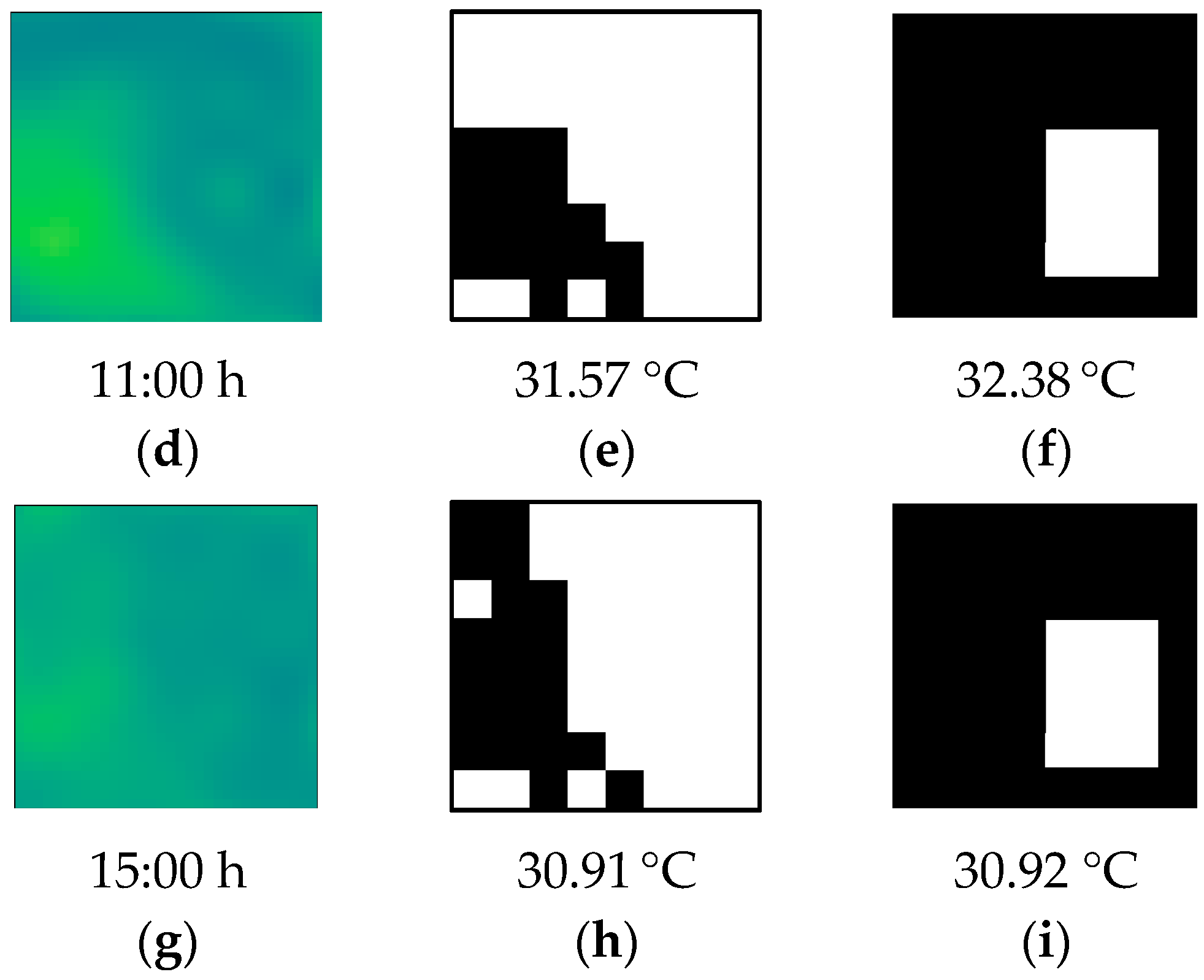
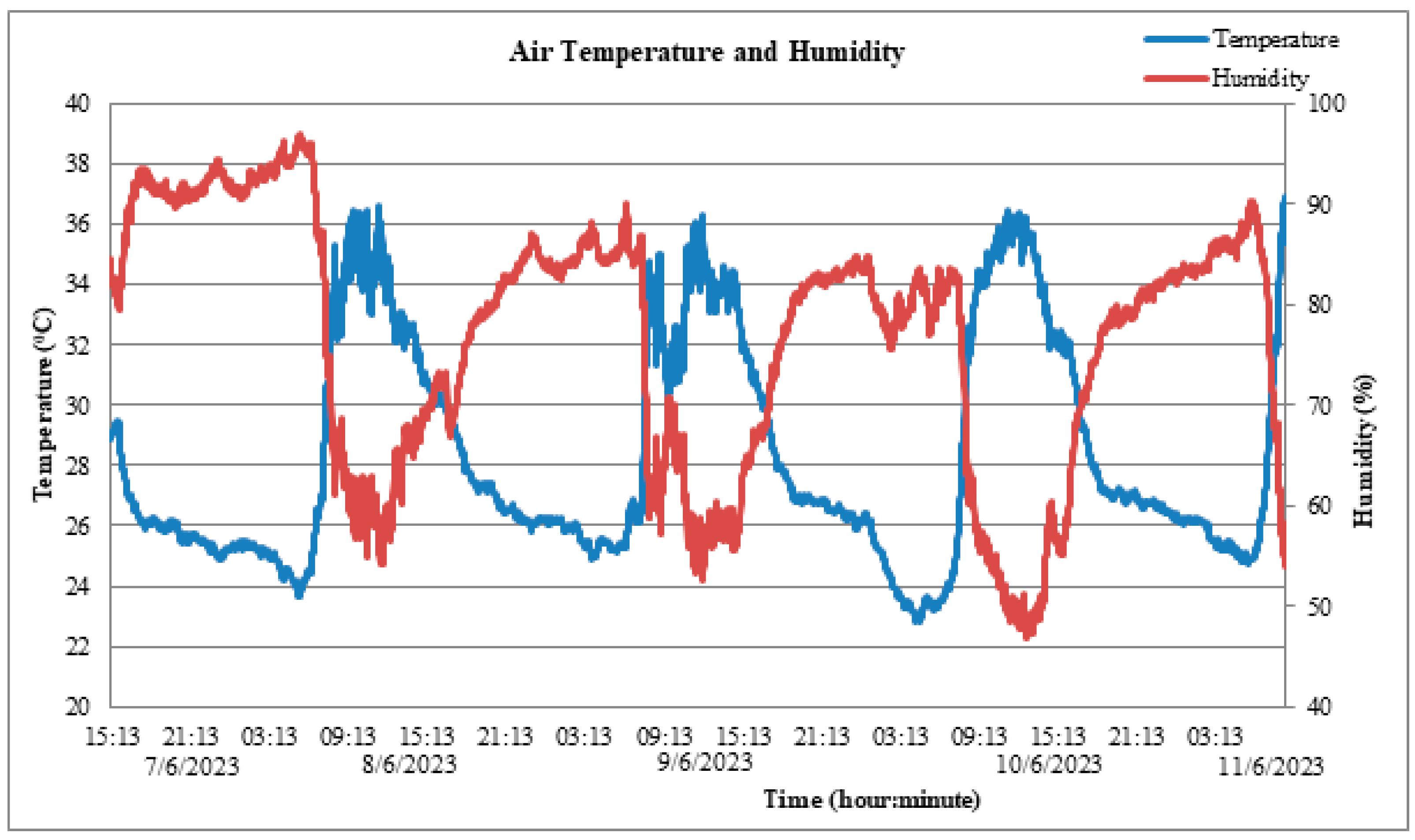
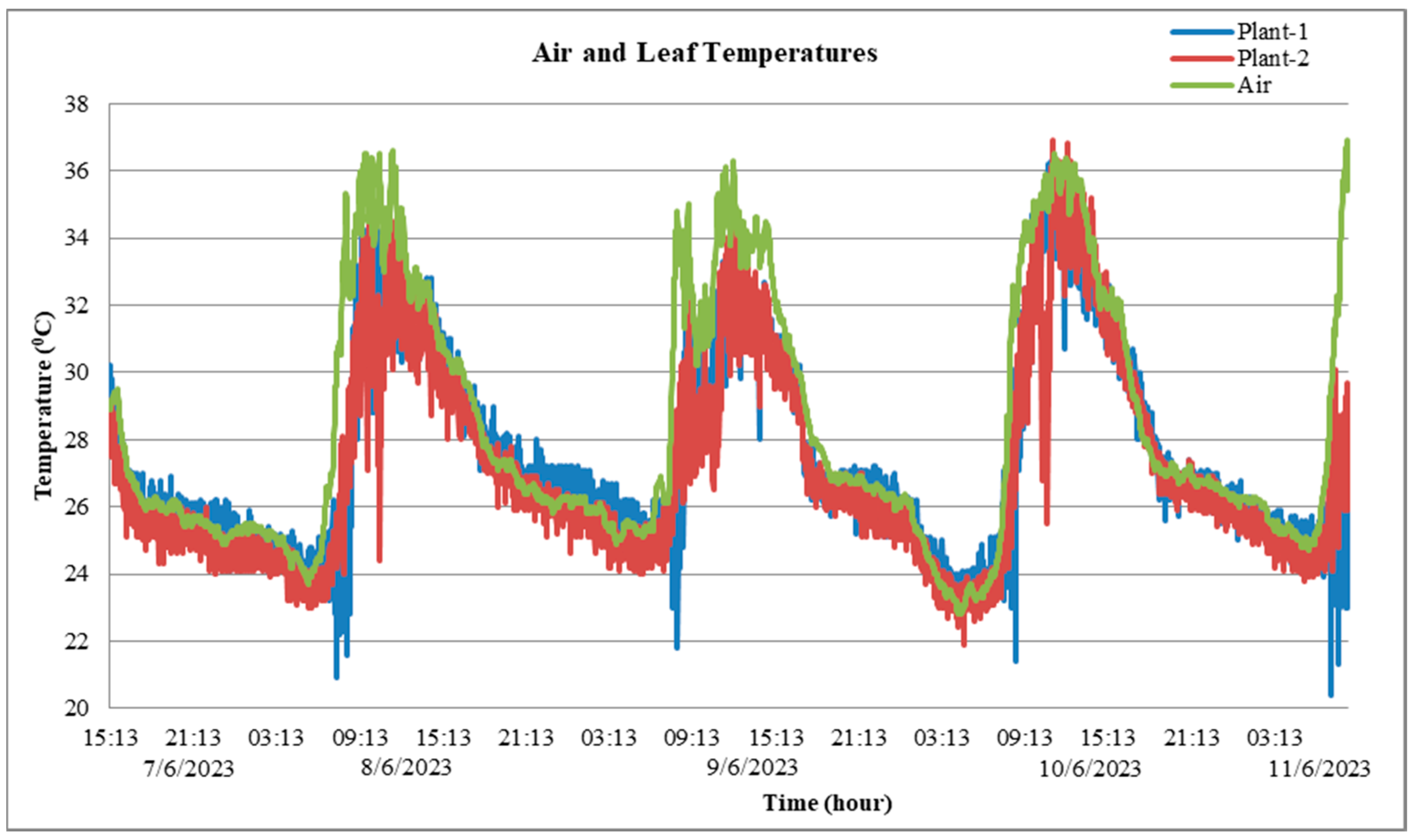
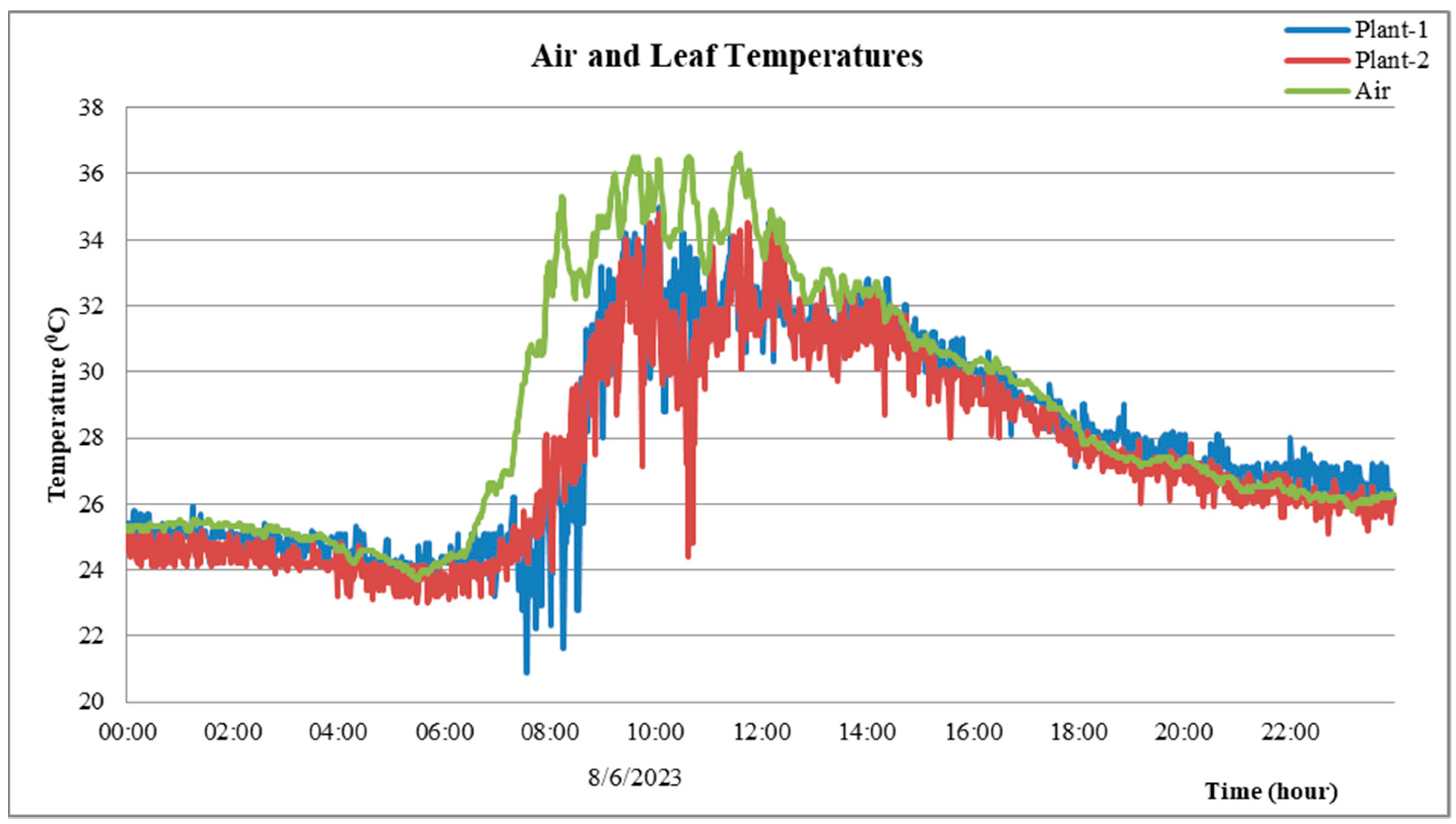
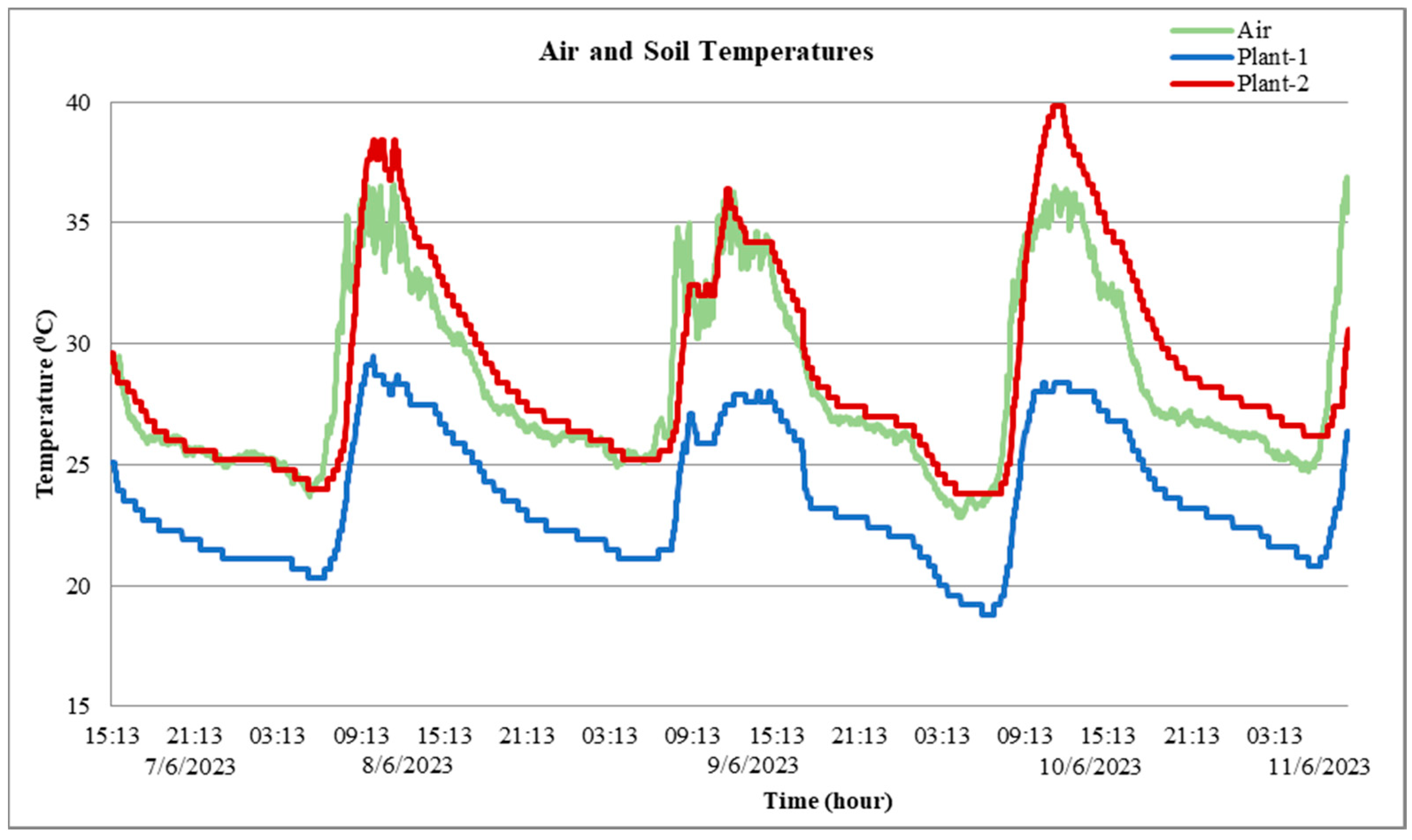
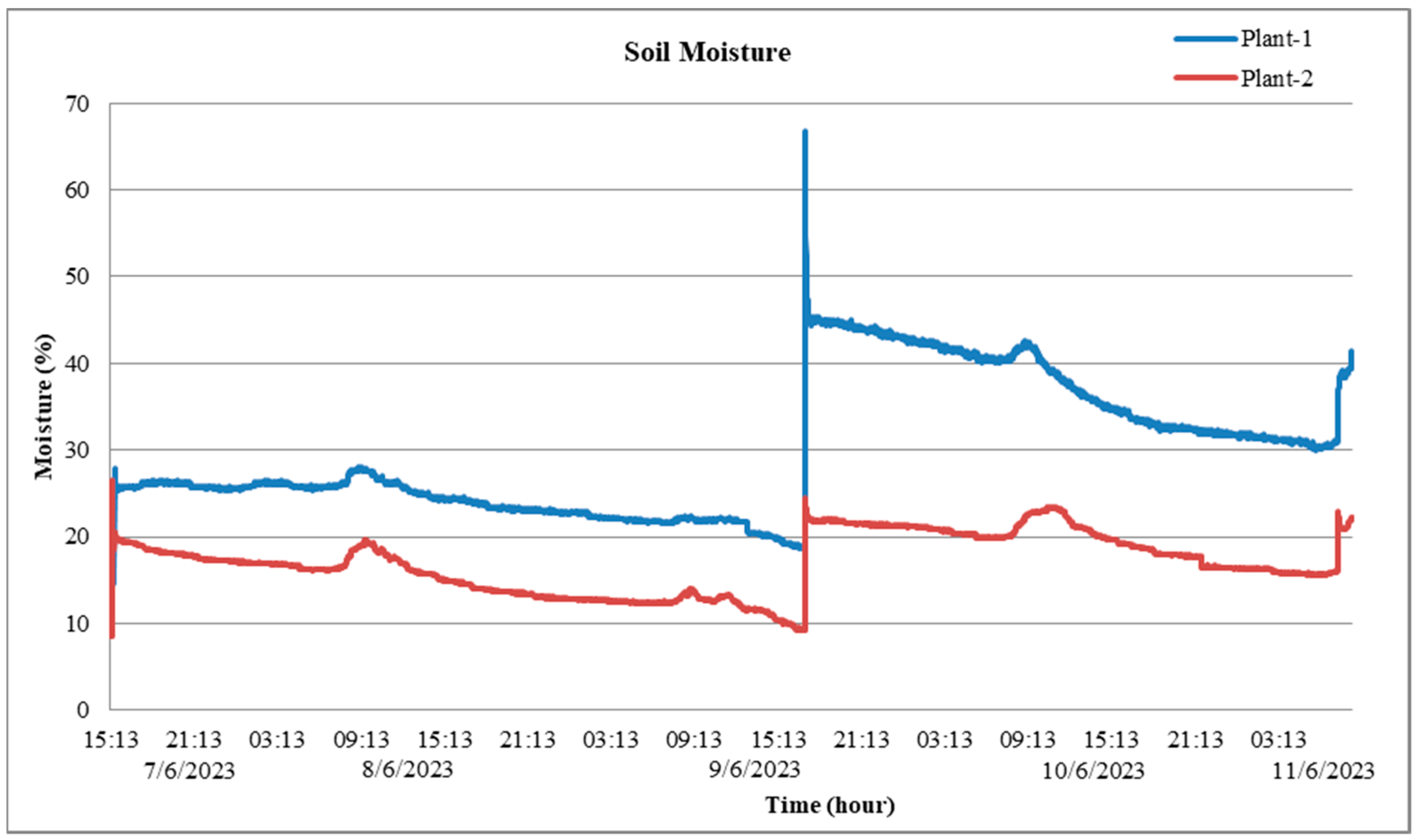
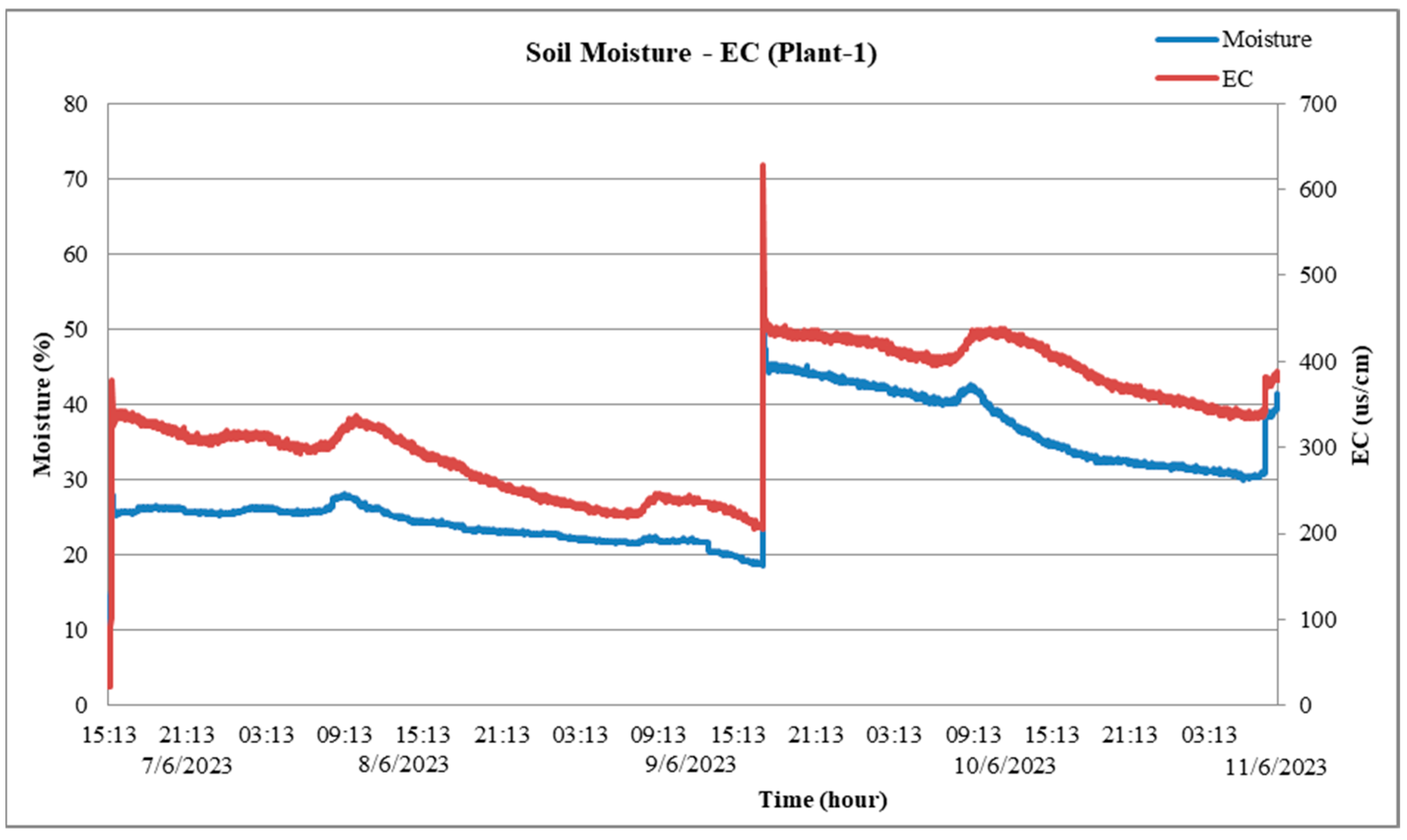
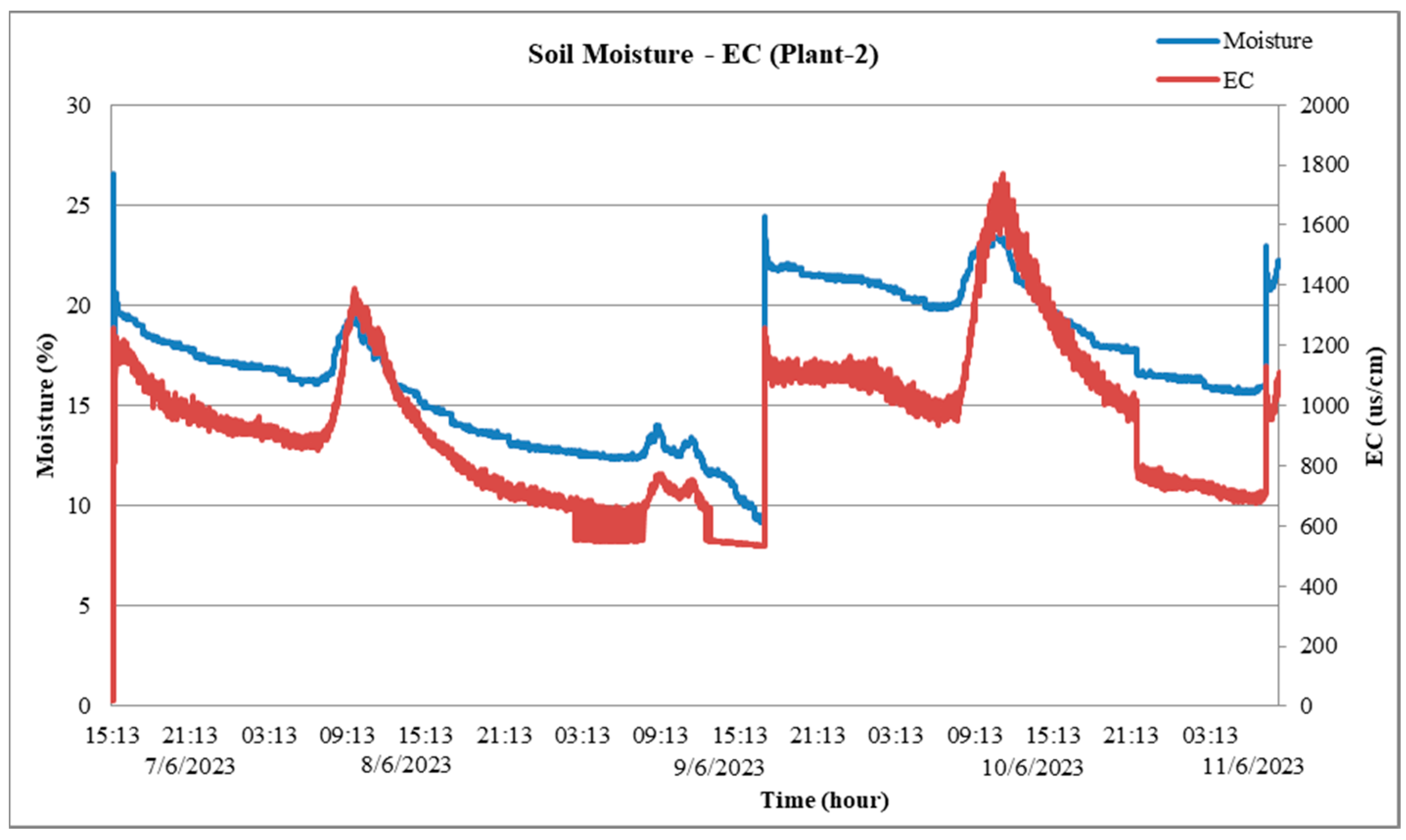

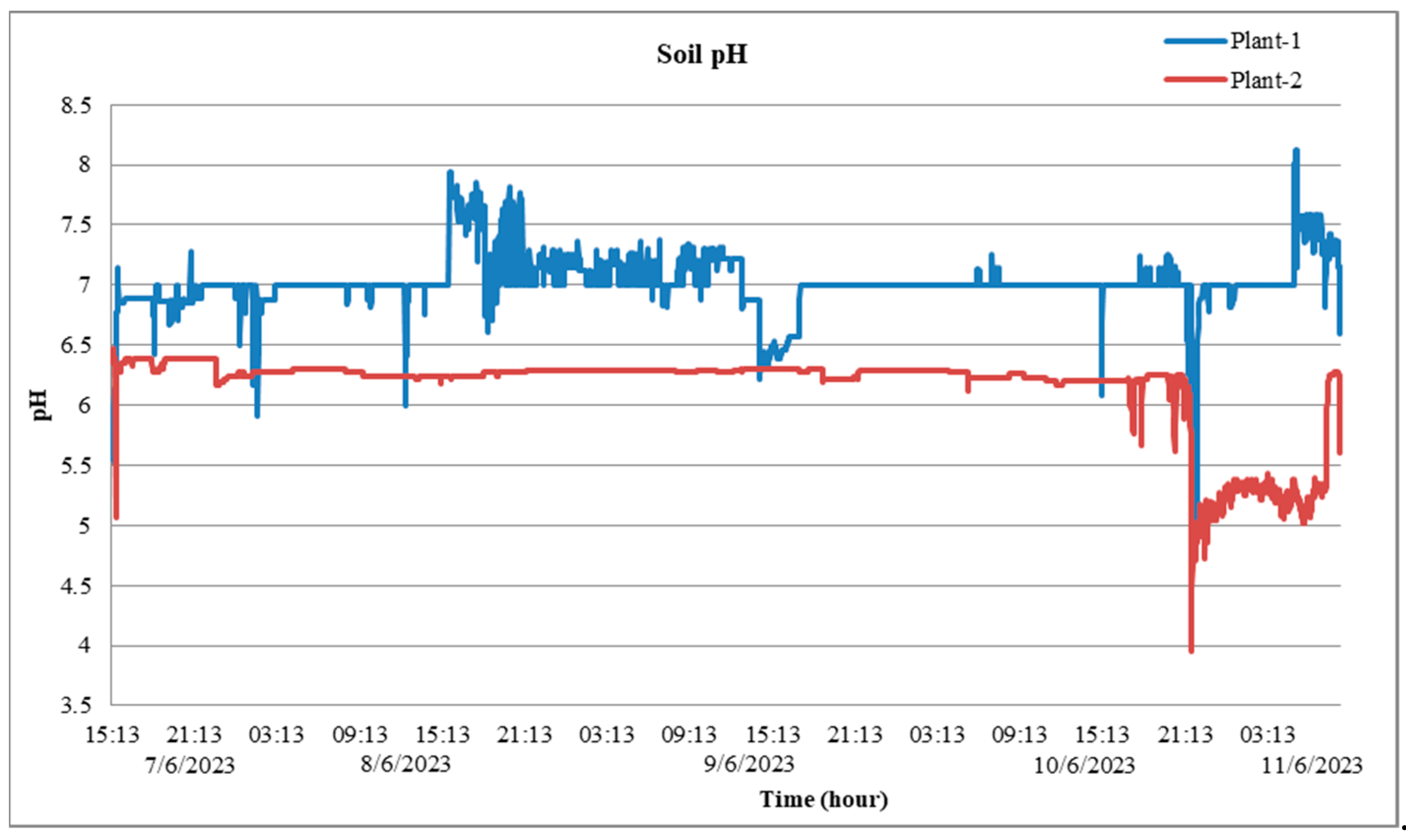
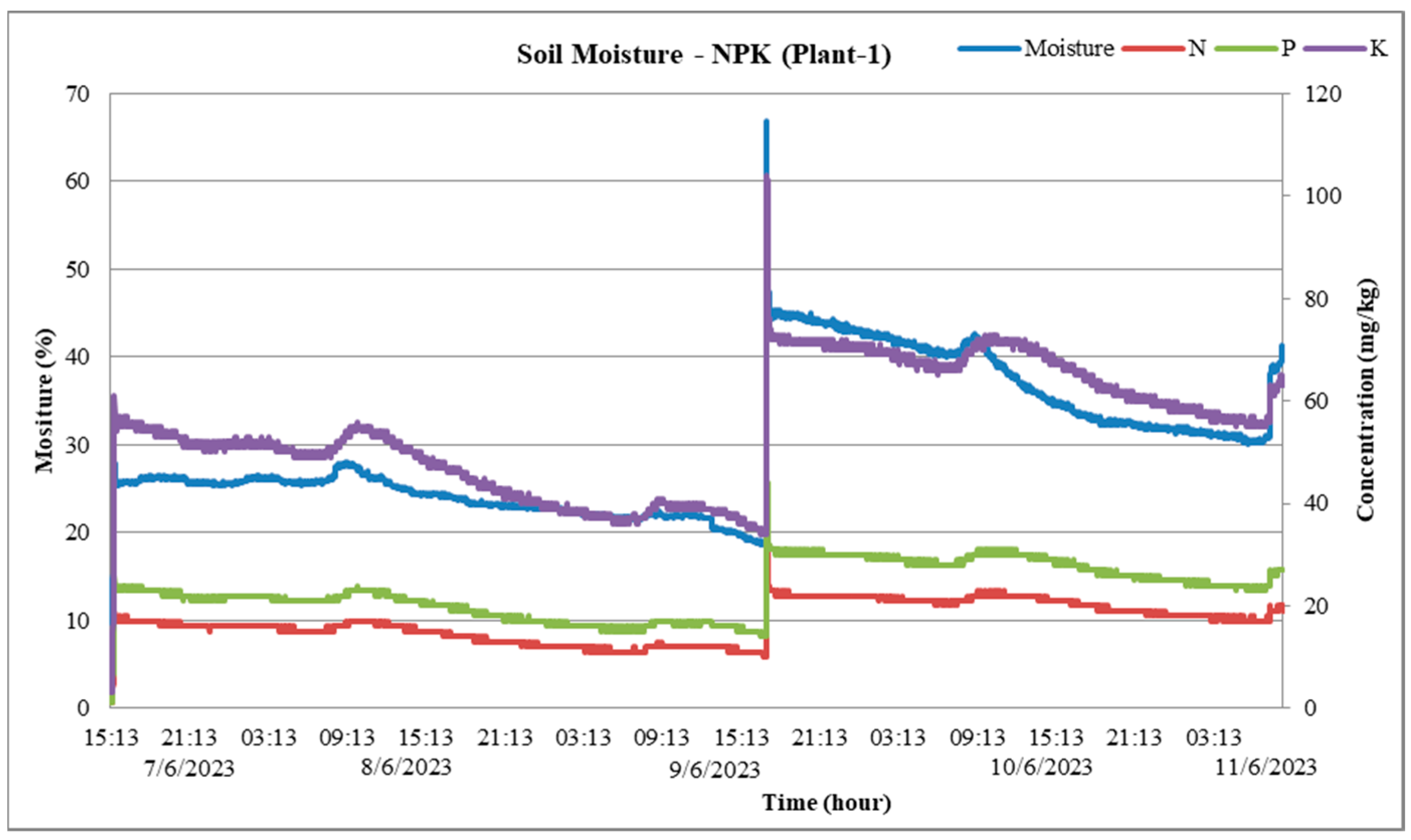
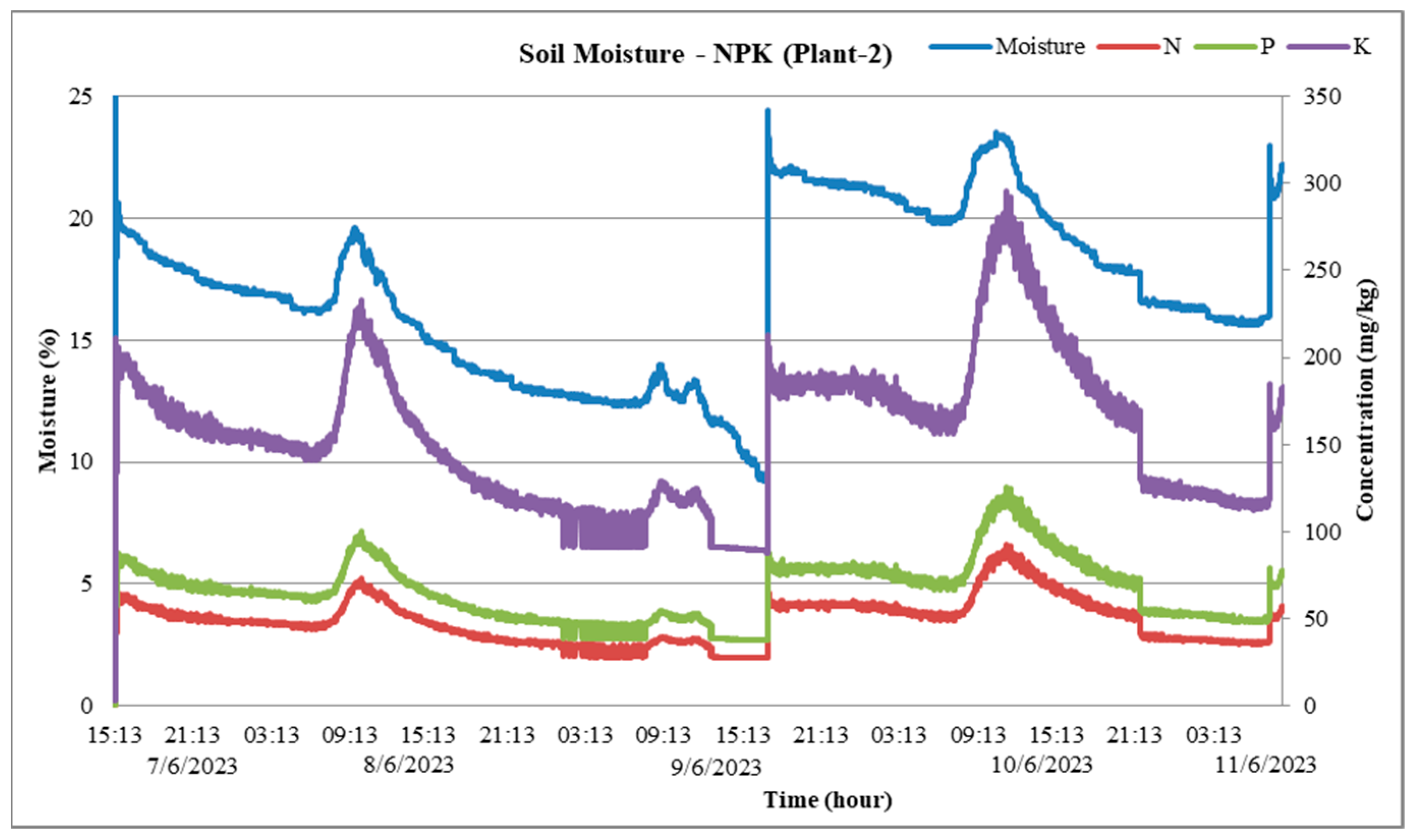

| Ref. | Parameter | Sensor Hardware | IoT | Remark |
|---|---|---|---|---|
| [7] | Leaf temperature | FLIR Vue Pro R | - | Standalone thermal camera (640 × 512 pixels) |
| [8] | Leaf temperature | FLIR P660 | - | Standalone thermal camera (640 × 480 pixels) |
| [9] | Leaf temperature | FLIR C2 | - | Standalone thermal camera (80 × 60 pixels) |
| [10] | Leaf temperature | FLIR Lepton 3.5 | - | Thermal camera is connected to Raspberry Pi 4 |
| [11] | Leaf temperature | FLIR Lepton 3.5 | - | Thermal camera is connected to Raspberry Pi 3 |
| [12] | Leaf temperature | 16 × 4 Thermopile Array (DIWELL Electronics) | - | Thermopile array is connected to STM32L476 |
| [13] | Leaf temperature | MLX90620 | - | Thermopile array is connected to Arduino Mega |
| [14] | Air temperature and humidity | DHT11 | Blynk | DHT11 is connected to Arduino and ESP8266 WiFi module for IoT communication |
| [15] | Air temperature and humidity | DHT11 | Authors developed Android Appl. | DHT11 is connected to NodeMCU for IoT communication |
| [16] | Air temperature and humidity; soil temperature and moisture | SDI-12 sensors | ADCON | Sensors are connected to ADCON RTU for IoT communication |
| [17] | Air temperature and humidity; pressure; light; gas (H2, LPG, CH4, CO, alcohol, smoke) | SHT10; BMP180; LDR; MQ2 | Authors developed IoT-based SCADA | Sensors are connected to NodeMCU for IoT communication |
| [18] | Air temperature and humidity; soil temperature and moisture; CO2 | DHT11; TELESKY FC-28; MG811 | Huawei cloud | Sensors are connected to STM32L431 for IoT communication |
| [19] | Air temperature and humidity; soil moisture | DHT11; Capacitive soil moisture sensor | ThingSpeak; Blynk; Open as App | Sensors are connected to NodeMCU for IoT communication |
| [20] | Soil temperature, conductivity, humidity, and pH | No information provided | Amazon Web Services (AWS) | Sensors are connected to Raspberry Pi 3 for IoT communication |
| [21] | Air temperature and humidity; Light | DHT11; GY-30 | Authors developed Web application | Sensors are connected to NodeMCU and raspberry Pi for IoT communication |
| [22] | Air temperature and humidity; soil temperature and moisture; CO2; leaf humidity; light | RS-WS-N01-2; No information provided for soil and gas sensors; YT-YSW; RS-GZ-N02 | Authors developed Web application | Sensors are connected to data acquisition unit using LoRa communication |
| [23] | Air temperature, humidity, pressure, and gas; soil NPK | BME688; Taidacent and JXCT | ThingSpeak | NPK sensor is connected to ELEGOO Nano Board; Air sensor is connected to ESP8266 |
| [24] | Soil temperature, moisture, pH, and NPK | DS18B20; FC28; No information provided for soil pH and NPK | Amazon Web Services (AWS) | Sensors are connected to Arduino and NodeMCU for IoT communication |
| [25] | Soil temperature, moisture, humidity, and NPK | No information provided | ThingSpeak | Sensors are connected to Arduino for IoT communication |
| [26] | Soil temperature, electric conductivity, moisture, pH, and NPK | JXCT | Authors developed mobile application | Sensors are connected to ESP32 Wi-Fi/LoRa board for IoT communication |
| [27] | Soil NPK | Authors developed NPK sensor | Google cloud | Sensors are connected to Raspberry for IoT communication |
| [28] | Soil NPK | No information provided for NPK sensor | ThingSpeak | Sensors are connected to Arduino for IoT communication |
| Ref. | Field of Application | RTU Hardware | Protocol (RTU to MTU) | MTU (Software–Hardware) |
|---|---|---|---|---|
| [17] | Plant monitoring | NodeMCU | HTTP | Authors developed web application–Raspberry Pi |
| [33] | Power distribution system | No specific information provided | 6LoWPAN | No specific information provided |
| [34] | Microgrid testbed | Arduino | NRF24L01-SPI | Authors developed Web application–Raspberry Pi |
| [35] | Photovoltaic (PV) system | Raspberry Pi | HTTP | EmonCMS–Raspberry Pi |
| [36] | Photovoltaic (PV) system | Raspberry Pi | MQTT | ThingsBoard–Raspberry Pi |
| [37] | Hydropower system | ESP8266 | HTTP | Authors developed web application–no specific information provided |
| [38] | Photovoltaic (PV) system | ESP32 | HTTP | Thinger.IO–Raspberry Pi |
| [39] | Autonomous assembly system | No specific information provided | No specific information provided | No specific information provided |
| [40] | Wastewater treatment | NodeMCU | HTTP | Authors developed web application–free cloud server |
| [41] | Base Transceiver Station (BTS) | ESP32 | HTTP | Arduino IoT Cloud–Arduino IoT cloud server |
| [42] | Tunnel light control | Micro850 Programmable Controller | No specific information provided | No specific information provided |
| [43] | Education | ESP8266 | HTTP | Authors developed web application |
| [44] | Oil production | Arduino | HTTP | Node-RED IoT platform–computer server |
| [45] | Smarthome | Arduino | MQTT | Grafana–Raspberry Pi |
| [46] | General application | Computer (simulated sensors) | Modbus | EclipseSCADA–Computer server |
| [47] | Water pumping | Arduino | Firmata | Node-RED–Raspberry Pi |
| Temperature | Humidity | |
|---|---|---|
| Operating range | −40–80 °C | 0–100% RH |
| Resolution | 0.1 °C | 0.1% RH |
| Accuracy | ±0.5 °C | ±2% RH |
| Repeatability | ±0.2 °C | ±1% RH |
| Power supply range | 3.3–5.5 V DC | |
| Interface | Digital signal–single wire | |
| Average sensing time | 2 s | |
| Price | US$ 2 | |
| Temperature | Moisture | EC | pH | N | P | K | |
|---|---|---|---|---|---|---|---|
| Operating range | −40 to 80 °C | 0–100% | 0–10,000 μS/cm | 3–9 | 0–1999 mg/kg | ||
| Resolution | 0.1 °C | 0.1% | 10 us/cm | 0.01 | 1 mg/kg | ||
| Accuracy | ±0.5 °C | Within 0–53% ± 3%; within 53–100% ± 5% | - | ±0.3 | ±2% FS | ||
| Power supply | 12–24 V DC | ||||||
| Interface | RS485 Modbus protocol | ||||||
| Response time | <1 s | ||||||
| Price | US$ 267 | ||||||
| Power supply | 3.3 V DC |
| Temperature range | 0–80 °C |
| Temperature accuracy | ±2.5 °C |
| Viewing angle | 60° |
| Number of pixels | 8 × 8 pixels |
| Interface | I2C |
| Frame rate | 10 fps |
| Price | US$ 41 |
| Power supply | 5–18 V DC |
| Processor | Cortex-M3 |
| Main frequency | 96 MHz |
| Operating system | FreeRTOS |
| Wireless standard | 802.11 b/g/n |
| WiFi band | 2.412–2.484 GHz |
| Neywork protocol | IP, TCP, UDP, DHCP, DNS, HTTP Server/Client, ARP, BOOTP, AutoIP, ICMP, Web socket, Telnet, uPNP, NTP, Modbus TCP |
| Network mode | STA/AP/STA + AP |
| Serial port | RS485 |
| Price | US$ 17 |
| Power supply | 24 ± 20% V DC |
| Software | Haiwell Cloud SCADA Version 3.36.9.8 |
| Display size | 7-inch TFT |
| Display resolution | 800 × 480 pixels |
| Touchscreen type | Resistive |
| Memory | Flash: 2 GB; RAM: 512 MB |
| I/O port | 1 × LAN; 2 × USB; 1 × RS485; 1 × RS232; 1 × WiFi |
| Common protocol | Modbus RTU; Modbus TCB |
| IoT protocol | MQTT |
| Supported RTU/PLC protocol | Haiwell; Schneider; Siemens; Panasonic; Mitsubishi; Omron; etc. |
| Function Code | Definition |
|---|---|
| 01 | Read Coils |
| 02 | Read Discrete Inputs |
| 05 | Write Single Coil |
| 15 | Write Multiple Coils |
| 03 | Read Holding Registers |
| 06 | Write Single Register |
| 16 | Write Multiple Register |
| Holding Register Address | Variable Name | Unit |
|---|---|---|
| 0–63 | Temperature value at array (0, 0)–(7, 7) of thermal camera | 0.1 °C |
| 64 | Air temperature value of DHT22 sensor * | 0.1 °C |
| 65 | Air humidity value of DHT22 sensor * | 0.1% |
| 66 | Average temperature value of thermal camera | 0.1 °C |
| 67 | Otsu threshold value | 0.1 °C |
| 68 | Background temperature value | 0.1 °C |
| 69 | Leaf temperature value | 0.1 °C |
| Holding Register Address | Variable Name | Unit |
|---|---|---|
| 6 | pH value | 0.01 pH |
| 18 | Soil moisture value | 0.1% RH |
| 19 | Soil temperature value | 0.1 °C |
| 21 | Soil conductivity value | us/cm |
| 30 | Nitrogen concentration value | mg/kg |
| 31 | Phosphorous concentration value | mg/kg |
| 32 | Kalium/Potassium concentration value | mg/kg |
| Collection Time | Data Recording Success Rate (DRSR) | |||||
|---|---|---|---|---|---|---|
| Raspberry Pi Zero W | Haiwell IoT Cloud HMI | |||||
| Plant-1 (DH22, AMG8833 #1) | Plant-2 (AMG8833 #2) | Plant-1 (DH22, AMG8833 #1) | Plant-2 (AMG8833) | Plant-1 (JXCT) | Plant-2 (JXCT) | |
| Day-1 (15:13–23:59 h) | 85.6% | 100% | 100% | 100% | 100% | 100% |
| Day-2 (00:00–23:59 h) | 88.6% | 100% | 100% | 100% | 100% | 100% |
| Day-3 (00:00–23:59 h) | 86.3% | 99.1% | 100% | 100% | 100% | 100% |
| Day-4 (00:00–23:59 h) | 88.1% | 100% | 100% | 100% | 100% | 100% |
| Day-5 (00:00–08:33 h) | 83.9% | 100% | 100% | 100% | 100% | 100% |
| Average | 86.5% | 99.8% | 100% | 100% | 100% | 100% |
| Leaf Temperature (°C) | Error (%) | ||
|---|---|---|---|
| Proposed Method | Manually | ||
| Plant-1 (Figure 14—21:00 h) | 26.19 | 26.11 | 0.31 |
| Plant-1 (Figure 14—11:00 h) | 32.05 | 31.69 | 1.14 |
| Plant-1 (Figure 14—15:00 h) | 31.94 | 31.46 | 1.53 |
| Plant-2 (Figure 15—21:00 h) | 25.71 | 25.78 | 0.27 |
| Plant-2 (Figure 15—11:00 h) | 31.57 | 32.38 | 2.50 |
| Plant-2 (Figure 15—15:00 h) | 30.91 | 30.92 | 0.03 |
| Leaf Temperature Measurement | ||
|---|---|---|
| Error (%) | Standard Deviation (%) | |
| Plant-1 | 1.41 | 0.96 |
| Plant-2 | 1.53 | 1.29 |
| Ref. | Monitoring Parameter | Field Device Implementation | Monitoring Dashboard | Monitoring Device | Cost (Approx.) |
|---|---|---|---|---|---|
| [7,8,9] | Leaf temperature | Handheld or portable thermal camera, Battery powered, Not IoT system | - | Thermal camera | >US$ 400 |
| [10,11] | Leaf temperature | Hardware prototype, DC power supply, Not IoT system | Python-based/Web API | Raspberry Pi | US$ 300 |
| [12] | Leaf temperature, Air temperature, humidity, CO2 | Hardware prototype, DC power supply, Not IoT system | LabView | PC | US$ 210 |
| [13] | Leaf temperature | Developed handheld device, Battery powered, Not IoT system | Arduino display | Arduino | US$ 158 |
| [14] | Air temperature and humidity | Hardware prototype, DC power supply, Not continuous monitoring, IoT system | Blynk App. | PC, Smartphone | US$ 35 |
| [16] | Air temperature and humidity; soil temperature and moisture | Commercial product (ADCON), Solar powered, IoT system | Grafana | PC | NA |
| [17] | Air temperature and humidity; pressure; light; gas (H2, LPG, CH4, CO, alcohol, smoke) | Hardware prototype, Battery powered, IoT system | Web-based GUI | PC, Smartphone | US$ 130 |
| [18] | Air temperature and humidity; soil temperature and moisture; CO2 | Hardware prototype, DC power supply, IoT system | Huawei cloud | PC, Smartphone | US$ 133 |
| [23] | Air temperature, humidity, pressure and gas; soil NPK | Hardware prototype, DC power supply, IoT system | ThingSpeak | PC, Smartphone | US$ 333 |
| [26] | Soil temperature, EC, moisture, pH, and NPK | Hardware prototype, Battery powered and solar panel, IoT system | Mobile application | Smartphone | US$ 300 |
| [27] | Soil NPK | Hardware prototype, Battery powered, IoT system | Google cloud | PC, Smartphone | US$ 55 |
| Proposed | Leaf temperature; air temperature and humidity; soil temperature, EC, moisture, pH, and NPK | Hardware prototype, DC power supply, IoT-based SCADA system | Haiwell SCADA HMI | PC, Smartphone, HMI panel | US$ 500 (including HMI device) |
Disclaimer/Publisher’s Note: The statements, opinions and data contained in all publications are solely those of the individual author(s) and contributor(s) and not of MDPI and/or the editor(s). MDPI and/or the editor(s) disclaim responsibility for any injury to people or property resulting from any ideas, methods, instructions or products referred to in the content. |
© 2023 by the authors. Licensee MDPI, Basel, Switzerland. This article is an open access article distributed under the terms and conditions of the Creative Commons Attribution (CC BY) license (https://creativecommons.org/licenses/by/4.0/).
Share and Cite
Soetedjo, A.; Hendriarianti, E. Development of an IoT-Based SCADA System for Monitoring of Plant Leaf Temperature and Air and Soil Parameters. Appl. Sci. 2023, 13, 11294. https://doi.org/10.3390/app132011294
Soetedjo A, Hendriarianti E. Development of an IoT-Based SCADA System for Monitoring of Plant Leaf Temperature and Air and Soil Parameters. Applied Sciences. 2023; 13(20):11294. https://doi.org/10.3390/app132011294
Chicago/Turabian StyleSoetedjo, Aryuanto, and Evy Hendriarianti. 2023. "Development of an IoT-Based SCADA System for Monitoring of Plant Leaf Temperature and Air and Soil Parameters" Applied Sciences 13, no. 20: 11294. https://doi.org/10.3390/app132011294
APA StyleSoetedjo, A., & Hendriarianti, E. (2023). Development of an IoT-Based SCADA System for Monitoring of Plant Leaf Temperature and Air and Soil Parameters. Applied Sciences, 13(20), 11294. https://doi.org/10.3390/app132011294






